Teaching and Education Analysis 2022
VerifiedAdded on 2022/10/16
|36
|8278
|38
AI Summary
Contribute Materials
Your contribution can guide someone’s learning journey. Share your
documents today.
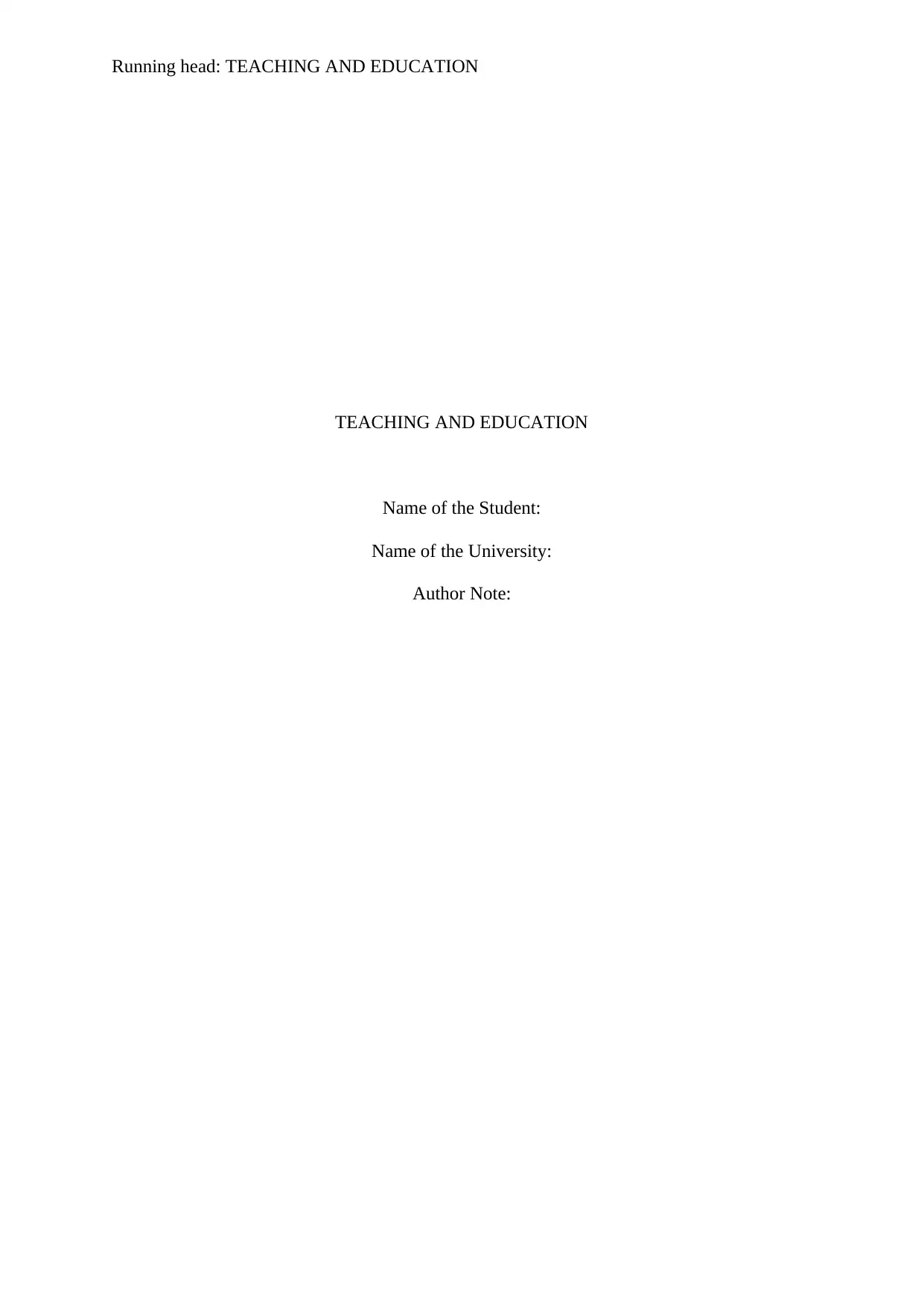
Running head: TEACHING AND EDUCATION
TEACHING AND EDUCATION
Name of the Student:
Name of the University:
Author Note:
TEACHING AND EDUCATION
Name of the Student:
Name of the University:
Author Note:
Secure Best Marks with AI Grader
Need help grading? Try our AI Grader for instant feedback on your assignments.
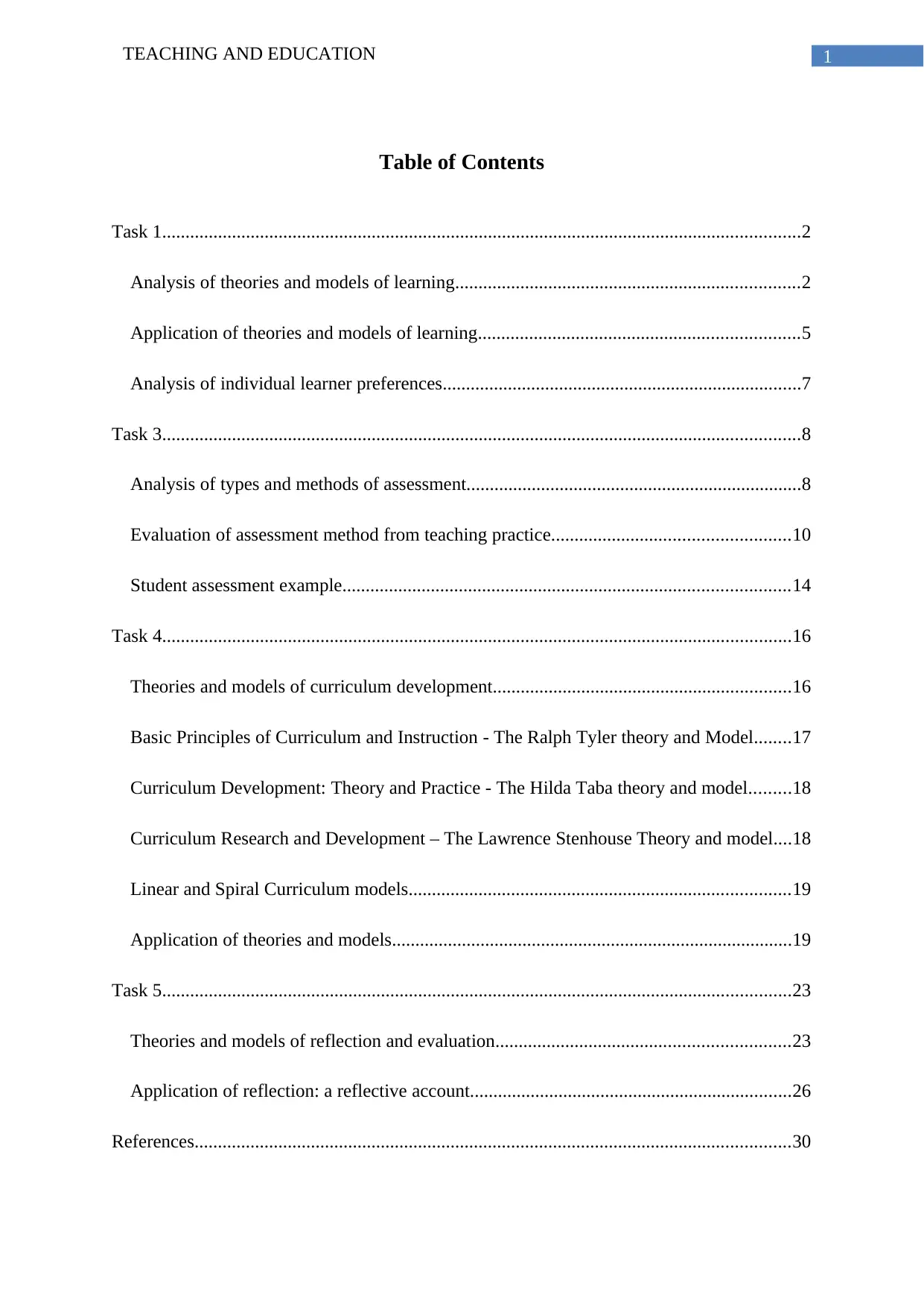
1TEACHING AND EDUCATION
Table of Contents
Task 1.........................................................................................................................................2
Analysis of theories and models of learning..........................................................................2
Application of theories and models of learning.....................................................................5
Analysis of individual learner preferences.............................................................................7
Task 3.........................................................................................................................................8
Analysis of types and methods of assessment........................................................................8
Evaluation of assessment method from teaching practice...................................................10
Student assessment example................................................................................................14
Task 4.......................................................................................................................................16
Theories and models of curriculum development................................................................16
Basic Principles of Curriculum and Instruction - The Ralph Tyler theory and Model........17
Curriculum Development: Theory and Practice - The Hilda Taba theory and model.........18
Curriculum Research and Development – The Lawrence Stenhouse Theory and model....18
Linear and Spiral Curriculum models..................................................................................19
Application of theories and models......................................................................................19
Task 5.......................................................................................................................................23
Theories and models of reflection and evaluation...............................................................23
Application of reflection: a reflective account.....................................................................26
References................................................................................................................................30
Table of Contents
Task 1.........................................................................................................................................2
Analysis of theories and models of learning..........................................................................2
Application of theories and models of learning.....................................................................5
Analysis of individual learner preferences.............................................................................7
Task 3.........................................................................................................................................8
Analysis of types and methods of assessment........................................................................8
Evaluation of assessment method from teaching practice...................................................10
Student assessment example................................................................................................14
Task 4.......................................................................................................................................16
Theories and models of curriculum development................................................................16
Basic Principles of Curriculum and Instruction - The Ralph Tyler theory and Model........17
Curriculum Development: Theory and Practice - The Hilda Taba theory and model.........18
Curriculum Research and Development – The Lawrence Stenhouse Theory and model....18
Linear and Spiral Curriculum models..................................................................................19
Application of theories and models......................................................................................19
Task 5.......................................................................................................................................23
Theories and models of reflection and evaluation...............................................................23
Application of reflection: a reflective account.....................................................................26
References................................................................................................................................30
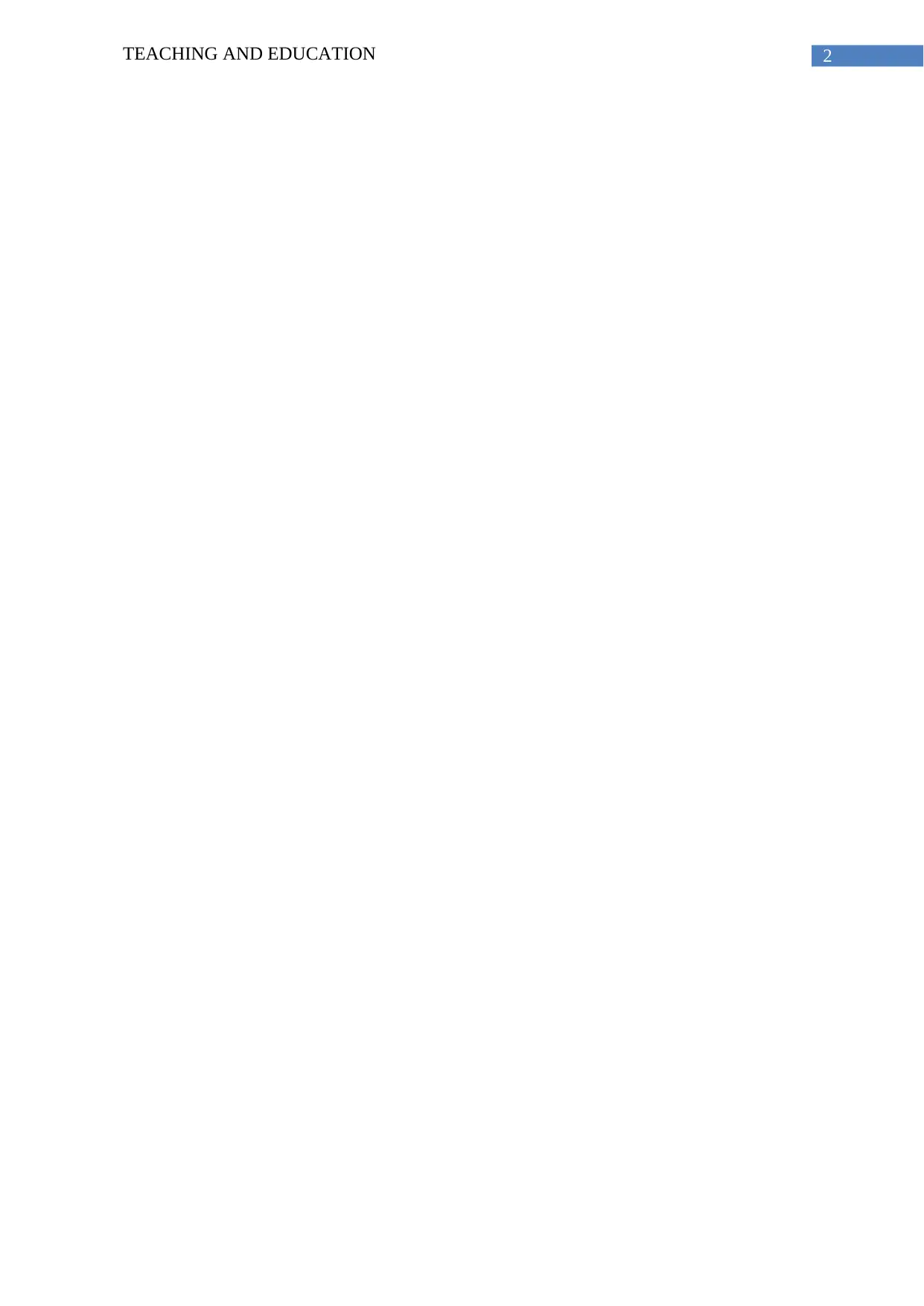
2TEACHING AND EDUCATION
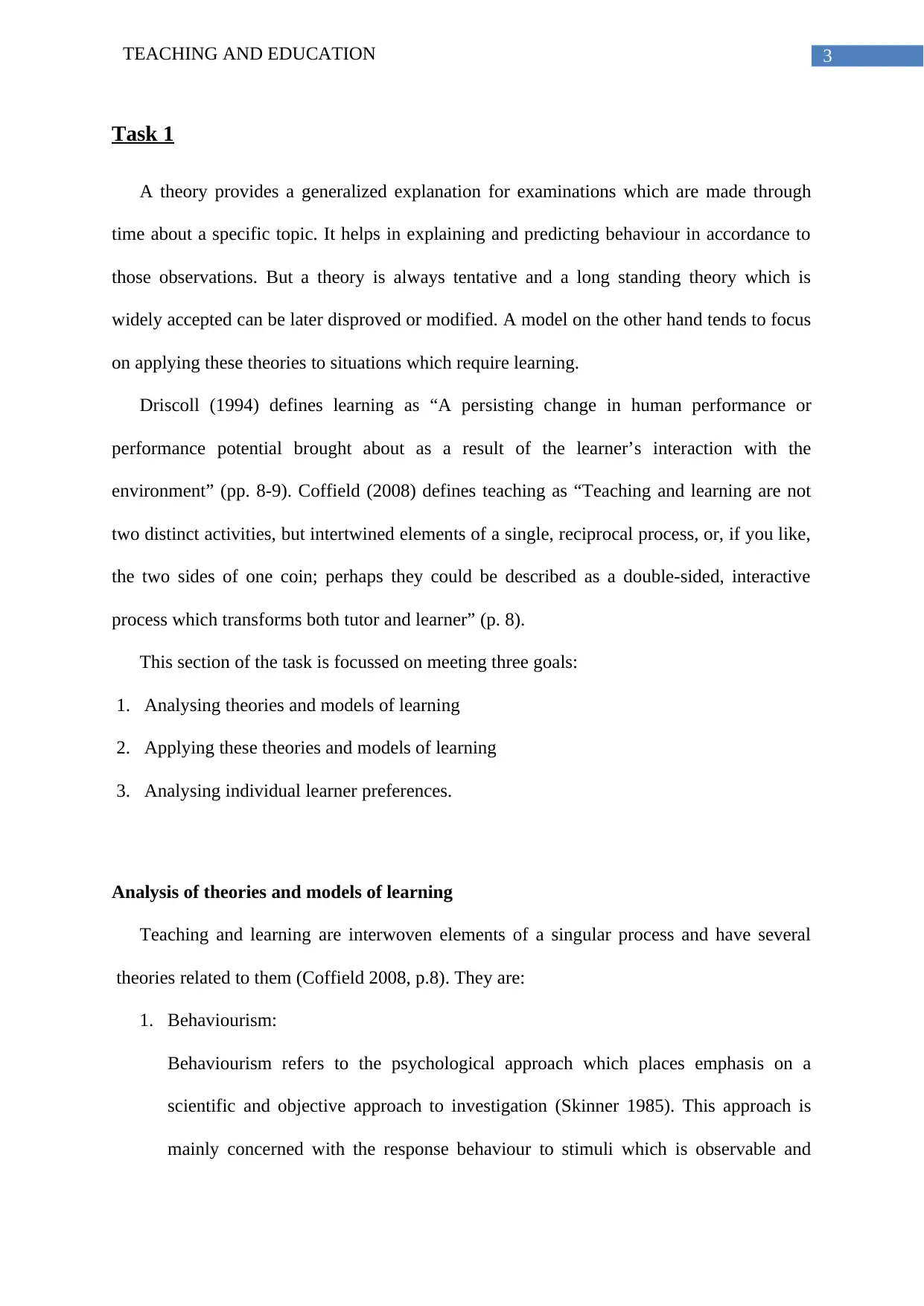
3TEACHING AND EDUCATION
Task 1
A theory provides a generalized explanation for examinations which are made through
time about a specific topic. It helps in explaining and predicting behaviour in accordance to
those observations. But a theory is always tentative and a long standing theory which is
widely accepted can be later disproved or modified. A model on the other hand tends to focus
on applying these theories to situations which require learning.
Driscoll (1994) defines learning as “A persisting change in human performance or
performance potential brought about as a result of the learner’s interaction with the
environment” (pp. 8-9). Coffield (2008) defines teaching as “Teaching and learning are not
two distinct activities, but intertwined elements of a single, reciprocal process, or, if you like,
the two sides of one coin; perhaps they could be described as a double-sided, interactive
process which transforms both tutor and learner” (p. 8).
This section of the task is focussed on meeting three goals:
1. Analysing theories and models of learning
2. Applying these theories and models of learning
3. Analysing individual learner preferences.
Analysis of theories and models of learning
Teaching and learning are interwoven elements of a singular process and have several
theories related to them (Coffield 2008, p.8). They are:
1. Behaviourism:
Behaviourism refers to the psychological approach which places emphasis on a
scientific and objective approach to investigation (Skinner 1985). This approach is
mainly concerned with the response behaviour to stimuli which is observable and
Task 1
A theory provides a generalized explanation for examinations which are made through
time about a specific topic. It helps in explaining and predicting behaviour in accordance to
those observations. But a theory is always tentative and a long standing theory which is
widely accepted can be later disproved or modified. A model on the other hand tends to focus
on applying these theories to situations which require learning.
Driscoll (1994) defines learning as “A persisting change in human performance or
performance potential brought about as a result of the learner’s interaction with the
environment” (pp. 8-9). Coffield (2008) defines teaching as “Teaching and learning are not
two distinct activities, but intertwined elements of a single, reciprocal process, or, if you like,
the two sides of one coin; perhaps they could be described as a double-sided, interactive
process which transforms both tutor and learner” (p. 8).
This section of the task is focussed on meeting three goals:
1. Analysing theories and models of learning
2. Applying these theories and models of learning
3. Analysing individual learner preferences.
Analysis of theories and models of learning
Teaching and learning are interwoven elements of a singular process and have several
theories related to them (Coffield 2008, p.8). They are:
1. Behaviourism:
Behaviourism refers to the psychological approach which places emphasis on a
scientific and objective approach to investigation (Skinner 1985). This approach is
mainly concerned with the response behaviour to stimuli which is observable and
Secure Best Marks with AI Grader
Need help grading? Try our AI Grader for instant feedback on your assignments.
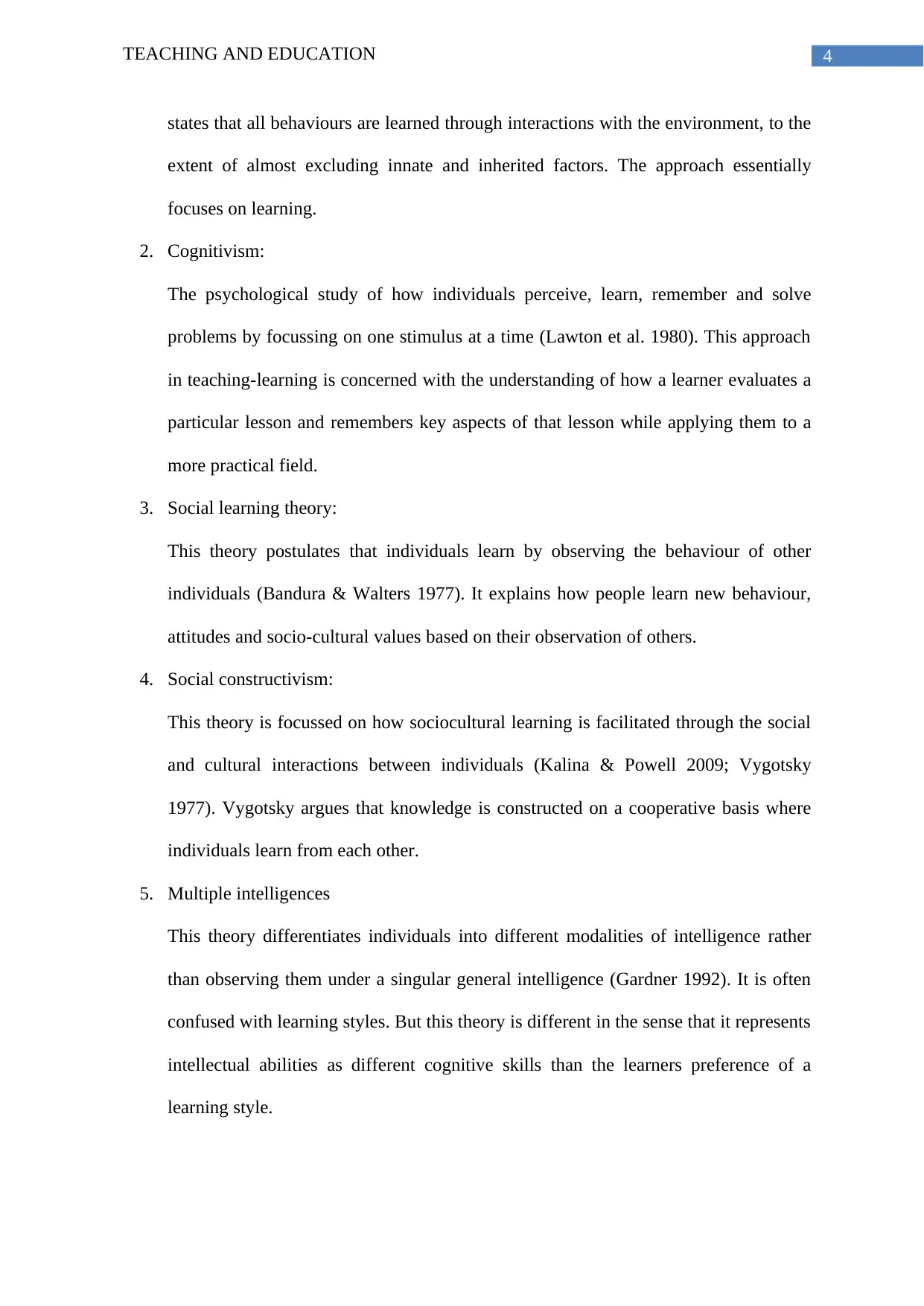
4TEACHING AND EDUCATION
states that all behaviours are learned through interactions with the environment, to the
extent of almost excluding innate and inherited factors. The approach essentially
focuses on learning.
2. Cognitivism:
The psychological study of how individuals perceive, learn, remember and solve
problems by focussing on one stimulus at a time (Lawton et al. 1980). This approach
in teaching-learning is concerned with the understanding of how a learner evaluates a
particular lesson and remembers key aspects of that lesson while applying them to a
more practical field.
3. Social learning theory:
This theory postulates that individuals learn by observing the behaviour of other
individuals (Bandura & Walters 1977). It explains how people learn new behaviour,
attitudes and socio-cultural values based on their observation of others.
4. Social constructivism:
This theory is focussed on how sociocultural learning is facilitated through the social
and cultural interactions between individuals (Kalina & Powell 2009; Vygotsky
1977). Vygotsky argues that knowledge is constructed on a cooperative basis where
individuals learn from each other.
5. Multiple intelligences
This theory differentiates individuals into different modalities of intelligence rather
than observing them under a singular general intelligence (Gardner 1992). It is often
confused with learning styles. But this theory is different in the sense that it represents
intellectual abilities as different cognitive skills than the learners preference of a
learning style.
states that all behaviours are learned through interactions with the environment, to the
extent of almost excluding innate and inherited factors. The approach essentially
focuses on learning.
2. Cognitivism:
The psychological study of how individuals perceive, learn, remember and solve
problems by focussing on one stimulus at a time (Lawton et al. 1980). This approach
in teaching-learning is concerned with the understanding of how a learner evaluates a
particular lesson and remembers key aspects of that lesson while applying them to a
more practical field.
3. Social learning theory:
This theory postulates that individuals learn by observing the behaviour of other
individuals (Bandura & Walters 1977). It explains how people learn new behaviour,
attitudes and socio-cultural values based on their observation of others.
4. Social constructivism:
This theory is focussed on how sociocultural learning is facilitated through the social
and cultural interactions between individuals (Kalina & Powell 2009; Vygotsky
1977). Vygotsky argues that knowledge is constructed on a cooperative basis where
individuals learn from each other.
5. Multiple intelligences
This theory differentiates individuals into different modalities of intelligence rather
than observing them under a singular general intelligence (Gardner 1992). It is often
confused with learning styles. But this theory is different in the sense that it represents
intellectual abilities as different cognitive skills than the learners preference of a
learning style.
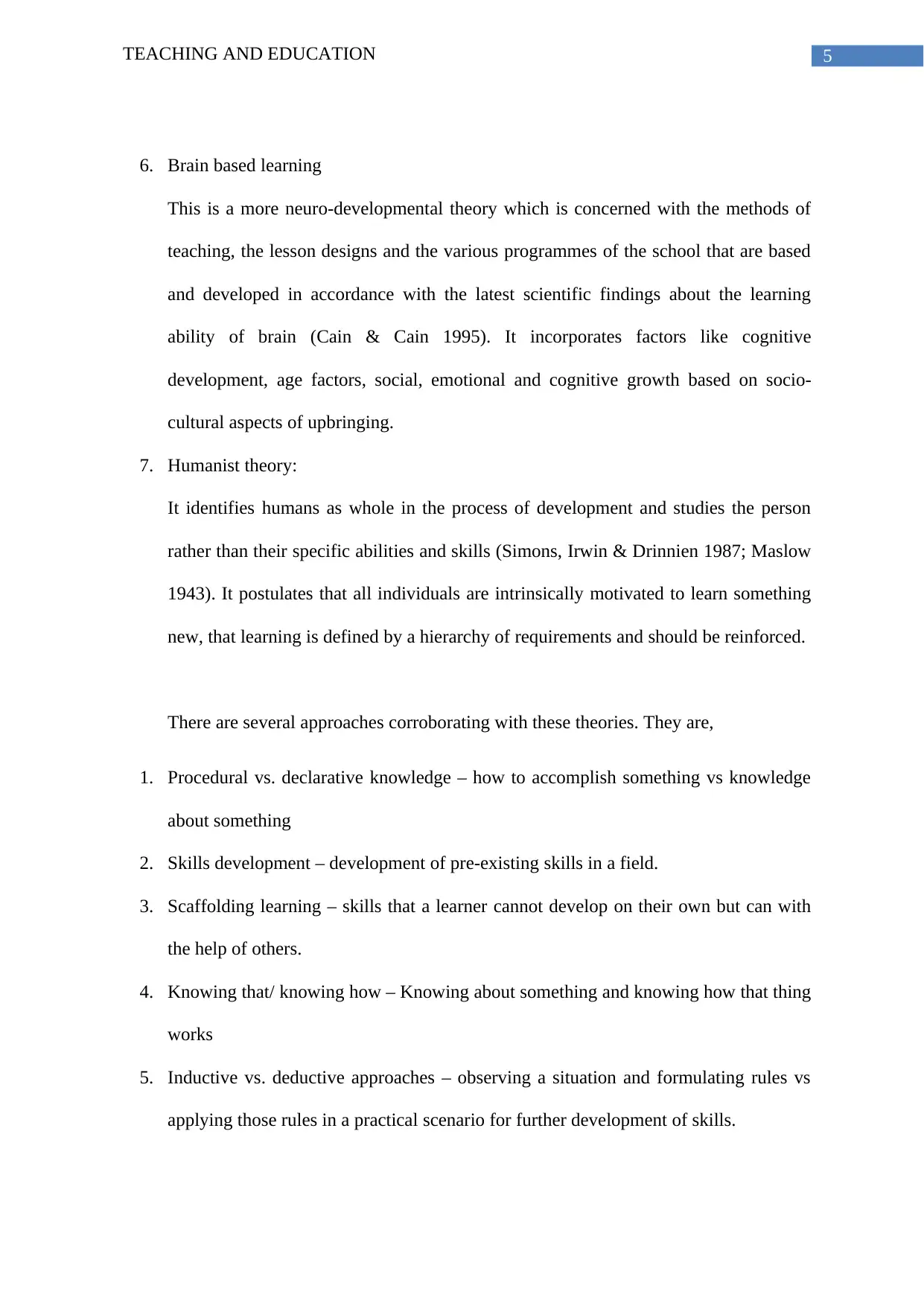
5TEACHING AND EDUCATION
6. Brain based learning
This is a more neuro-developmental theory which is concerned with the methods of
teaching, the lesson designs and the various programmes of the school that are based
and developed in accordance with the latest scientific findings about the learning
ability of brain (Cain & Cain 1995). It incorporates factors like cognitive
development, age factors, social, emotional and cognitive growth based on socio-
cultural aspects of upbringing.
7. Humanist theory:
It identifies humans as whole in the process of development and studies the person
rather than their specific abilities and skills (Simons, Irwin & Drinnien 1987; Maslow
1943). It postulates that all individuals are intrinsically motivated to learn something
new, that learning is defined by a hierarchy of requirements and should be reinforced.
There are several approaches corroborating with these theories. They are,
1. Procedural vs. declarative knowledge – how to accomplish something vs knowledge
about something
2. Skills development – development of pre-existing skills in a field.
3. Scaffolding learning – skills that a learner cannot develop on their own but can with
the help of others.
4. Knowing that/ knowing how – Knowing about something and knowing how that thing
works
5. Inductive vs. deductive approaches – observing a situation and formulating rules vs
applying those rules in a practical scenario for further development of skills.
6. Brain based learning
This is a more neuro-developmental theory which is concerned with the methods of
teaching, the lesson designs and the various programmes of the school that are based
and developed in accordance with the latest scientific findings about the learning
ability of brain (Cain & Cain 1995). It incorporates factors like cognitive
development, age factors, social, emotional and cognitive growth based on socio-
cultural aspects of upbringing.
7. Humanist theory:
It identifies humans as whole in the process of development and studies the person
rather than their specific abilities and skills (Simons, Irwin & Drinnien 1987; Maslow
1943). It postulates that all individuals are intrinsically motivated to learn something
new, that learning is defined by a hierarchy of requirements and should be reinforced.
There are several approaches corroborating with these theories. They are,
1. Procedural vs. declarative knowledge – how to accomplish something vs knowledge
about something
2. Skills development – development of pre-existing skills in a field.
3. Scaffolding learning – skills that a learner cannot develop on their own but can with
the help of others.
4. Knowing that/ knowing how – Knowing about something and knowing how that thing
works
5. Inductive vs. deductive approaches – observing a situation and formulating rules vs
applying those rules in a practical scenario for further development of skills.
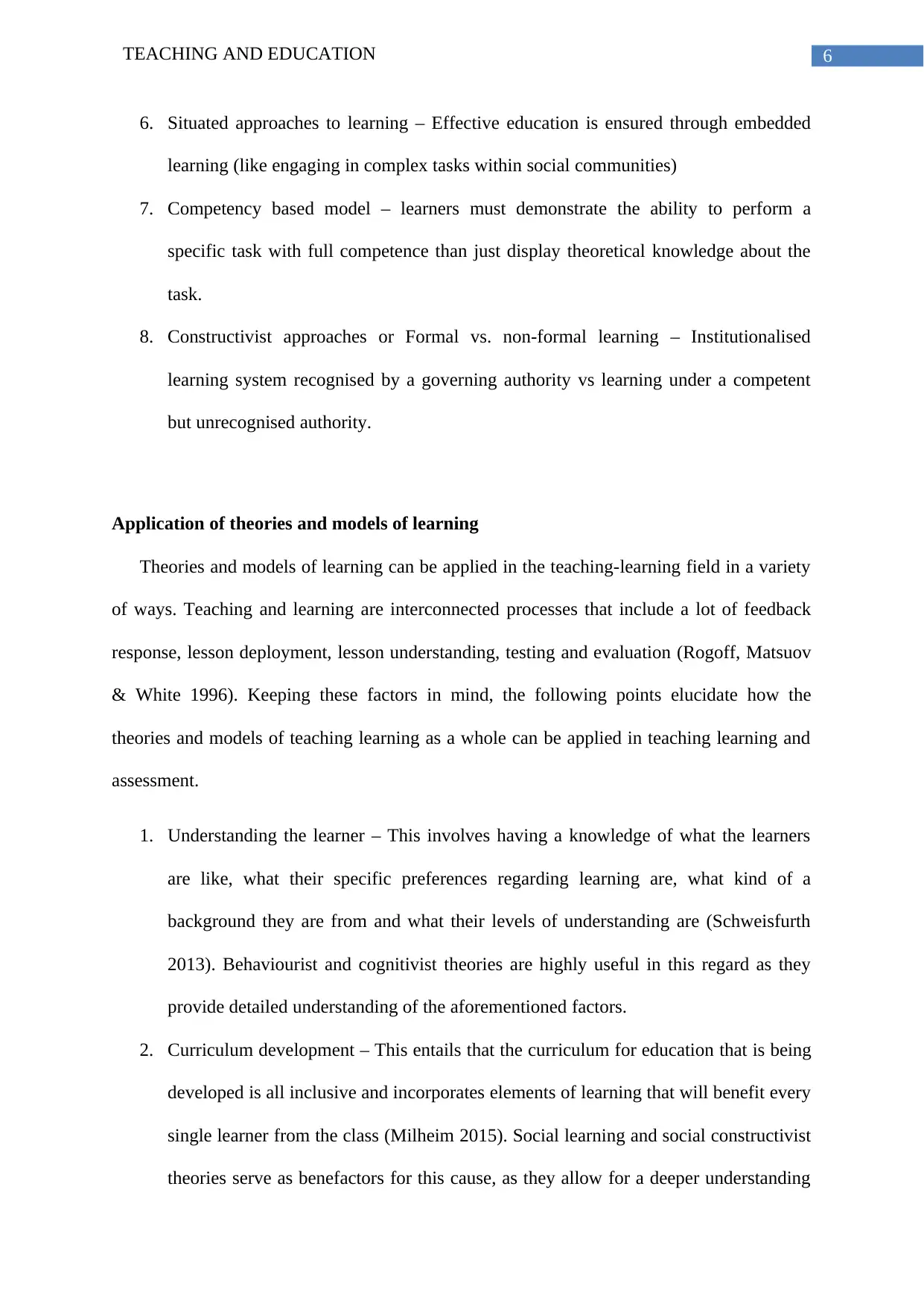
6TEACHING AND EDUCATION
6. Situated approaches to learning – Effective education is ensured through embedded
learning (like engaging in complex tasks within social communities)
7. Competency based model – learners must demonstrate the ability to perform a
specific task with full competence than just display theoretical knowledge about the
task.
8. Constructivist approaches or Formal vs. non-formal learning – Institutionalised
learning system recognised by a governing authority vs learning under a competent
but unrecognised authority.
Application of theories and models of learning
Theories and models of learning can be applied in the teaching-learning field in a variety
of ways. Teaching and learning are interconnected processes that include a lot of feedback
response, lesson deployment, lesson understanding, testing and evaluation (Rogoff, Matsuov
& White 1996). Keeping these factors in mind, the following points elucidate how the
theories and models of teaching learning as a whole can be applied in teaching learning and
assessment.
1. Understanding the learner – This involves having a knowledge of what the learners
are like, what their specific preferences regarding learning are, what kind of a
background they are from and what their levels of understanding are (Schweisfurth
2013). Behaviourist and cognitivist theories are highly useful in this regard as they
provide detailed understanding of the aforementioned factors.
2. Curriculum development – This entails that the curriculum for education that is being
developed is all inclusive and incorporates elements of learning that will benefit every
single learner from the class (Milheim 2015). Social learning and social constructivist
theories serve as benefactors for this cause, as they allow for a deeper understanding
6. Situated approaches to learning – Effective education is ensured through embedded
learning (like engaging in complex tasks within social communities)
7. Competency based model – learners must demonstrate the ability to perform a
specific task with full competence than just display theoretical knowledge about the
task.
8. Constructivist approaches or Formal vs. non-formal learning – Institutionalised
learning system recognised by a governing authority vs learning under a competent
but unrecognised authority.
Application of theories and models of learning
Theories and models of learning can be applied in the teaching-learning field in a variety
of ways. Teaching and learning are interconnected processes that include a lot of feedback
response, lesson deployment, lesson understanding, testing and evaluation (Rogoff, Matsuov
& White 1996). Keeping these factors in mind, the following points elucidate how the
theories and models of teaching learning as a whole can be applied in teaching learning and
assessment.
1. Understanding the learner – This involves having a knowledge of what the learners
are like, what their specific preferences regarding learning are, what kind of a
background they are from and what their levels of understanding are (Schweisfurth
2013). Behaviourist and cognitivist theories are highly useful in this regard as they
provide detailed understanding of the aforementioned factors.
2. Curriculum development – This entails that the curriculum for education that is being
developed is all inclusive and incorporates elements of learning that will benefit every
single learner from the class (Milheim 2015). Social learning and social constructivist
theories serve as benefactors for this cause, as they allow for a deeper understanding
Paraphrase This Document
Need a fresh take? Get an instant paraphrase of this document with our AI Paraphraser
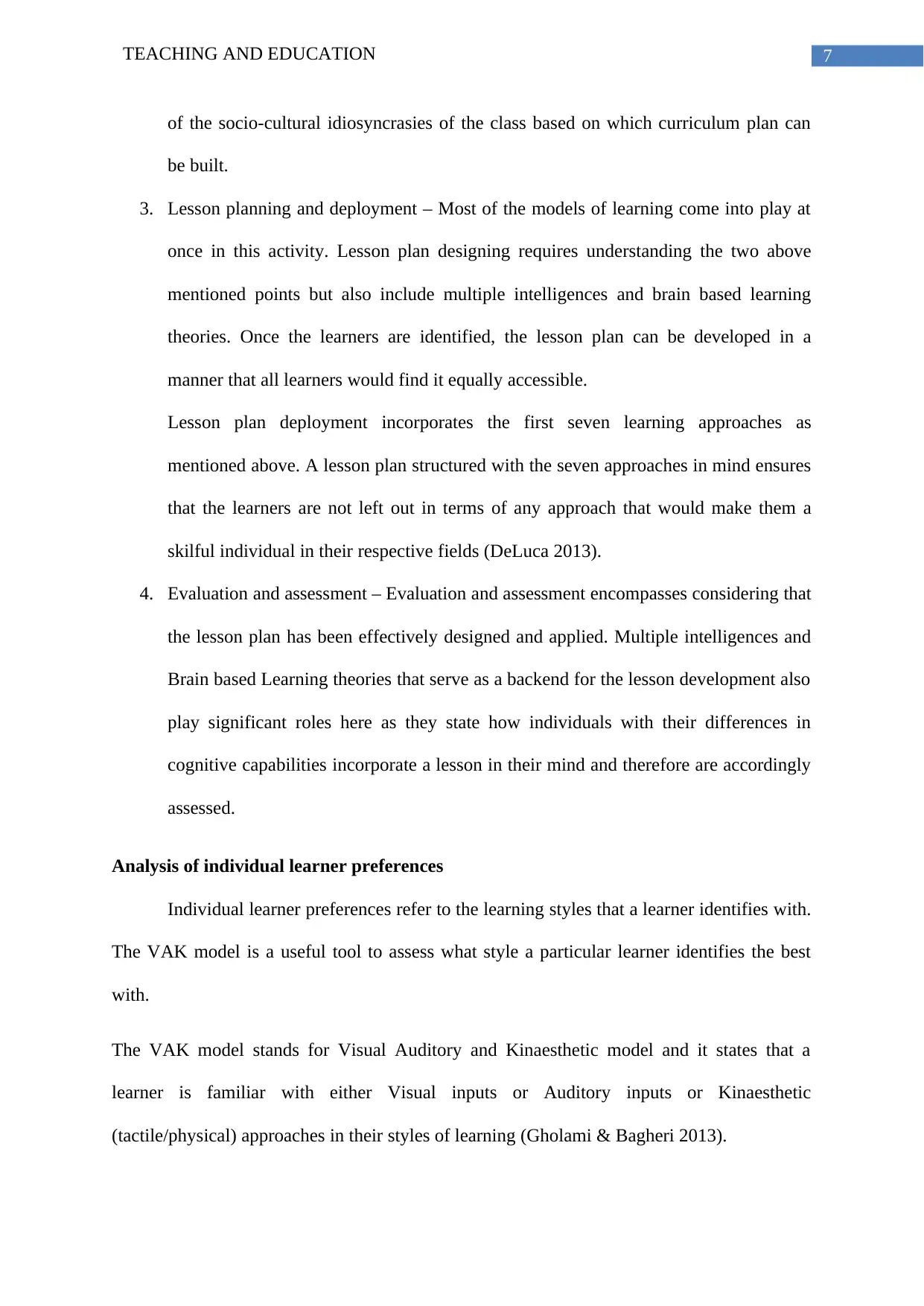
7TEACHING AND EDUCATION
of the socio-cultural idiosyncrasies of the class based on which curriculum plan can
be built.
3. Lesson planning and deployment – Most of the models of learning come into play at
once in this activity. Lesson plan designing requires understanding the two above
mentioned points but also include multiple intelligences and brain based learning
theories. Once the learners are identified, the lesson plan can be developed in a
manner that all learners would find it equally accessible.
Lesson plan deployment incorporates the first seven learning approaches as
mentioned above. A lesson plan structured with the seven approaches in mind ensures
that the learners are not left out in terms of any approach that would make them a
skilful individual in their respective fields (DeLuca 2013).
4. Evaluation and assessment – Evaluation and assessment encompasses considering that
the lesson plan has been effectively designed and applied. Multiple intelligences and
Brain based Learning theories that serve as a backend for the lesson development also
play significant roles here as they state how individuals with their differences in
cognitive capabilities incorporate a lesson in their mind and therefore are accordingly
assessed.
Analysis of individual learner preferences
Individual learner preferences refer to the learning styles that a learner identifies with.
The VAK model is a useful tool to assess what style a particular learner identifies the best
with.
The VAK model stands for Visual Auditory and Kinaesthetic model and it states that a
learner is familiar with either Visual inputs or Auditory inputs or Kinaesthetic
(tactile/physical) approaches in their styles of learning (Gholami & Bagheri 2013).
of the socio-cultural idiosyncrasies of the class based on which curriculum plan can
be built.
3. Lesson planning and deployment – Most of the models of learning come into play at
once in this activity. Lesson plan designing requires understanding the two above
mentioned points but also include multiple intelligences and brain based learning
theories. Once the learners are identified, the lesson plan can be developed in a
manner that all learners would find it equally accessible.
Lesson plan deployment incorporates the first seven learning approaches as
mentioned above. A lesson plan structured with the seven approaches in mind ensures
that the learners are not left out in terms of any approach that would make them a
skilful individual in their respective fields (DeLuca 2013).
4. Evaluation and assessment – Evaluation and assessment encompasses considering that
the lesson plan has been effectively designed and applied. Multiple intelligences and
Brain based Learning theories that serve as a backend for the lesson development also
play significant roles here as they state how individuals with their differences in
cognitive capabilities incorporate a lesson in their mind and therefore are accordingly
assessed.
Analysis of individual learner preferences
Individual learner preferences refer to the learning styles that a learner identifies with.
The VAK model is a useful tool to assess what style a particular learner identifies the best
with.
The VAK model stands for Visual Auditory and Kinaesthetic model and it states that a
learner is familiar with either Visual inputs or Auditory inputs or Kinaesthetic
(tactile/physical) approaches in their styles of learning (Gholami & Bagheri 2013).
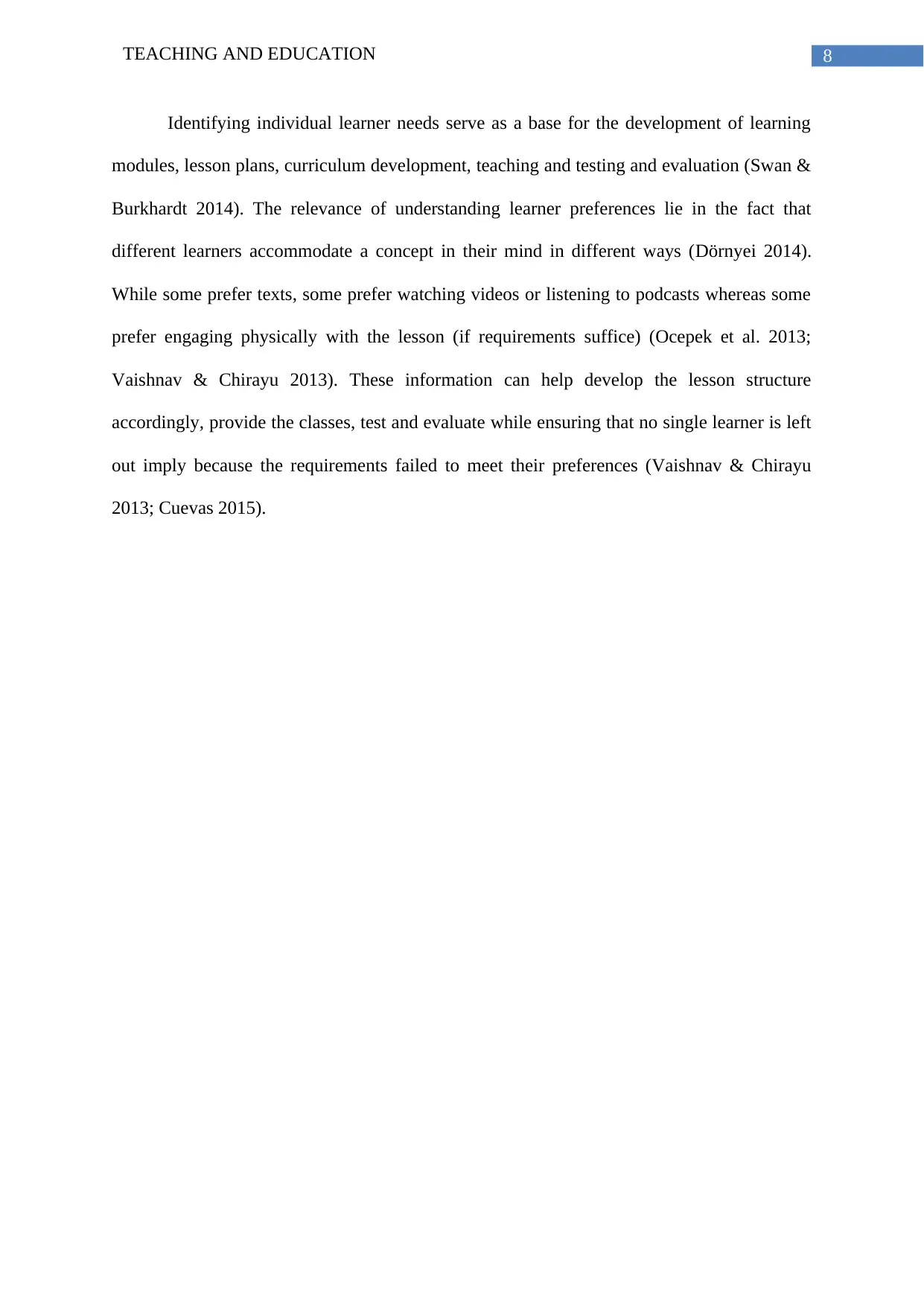
8TEACHING AND EDUCATION
Identifying individual learner needs serve as a base for the development of learning
modules, lesson plans, curriculum development, teaching and testing and evaluation (Swan &
Burkhardt 2014). The relevance of understanding learner preferences lie in the fact that
different learners accommodate a concept in their mind in different ways (Dörnyei 2014).
While some prefer texts, some prefer watching videos or listening to podcasts whereas some
prefer engaging physically with the lesson (if requirements suffice) (Ocepek et al. 2013;
Vaishnav & Chirayu 2013). These information can help develop the lesson structure
accordingly, provide the classes, test and evaluate while ensuring that no single learner is left
out imply because the requirements failed to meet their preferences (Vaishnav & Chirayu
2013; Cuevas 2015).
Identifying individual learner needs serve as a base for the development of learning
modules, lesson plans, curriculum development, teaching and testing and evaluation (Swan &
Burkhardt 2014). The relevance of understanding learner preferences lie in the fact that
different learners accommodate a concept in their mind in different ways (Dörnyei 2014).
While some prefer texts, some prefer watching videos or listening to podcasts whereas some
prefer engaging physically with the lesson (if requirements suffice) (Ocepek et al. 2013;
Vaishnav & Chirayu 2013). These information can help develop the lesson structure
accordingly, provide the classes, test and evaluate while ensuring that no single learner is left
out imply because the requirements failed to meet their preferences (Vaishnav & Chirayu
2013; Cuevas 2015).
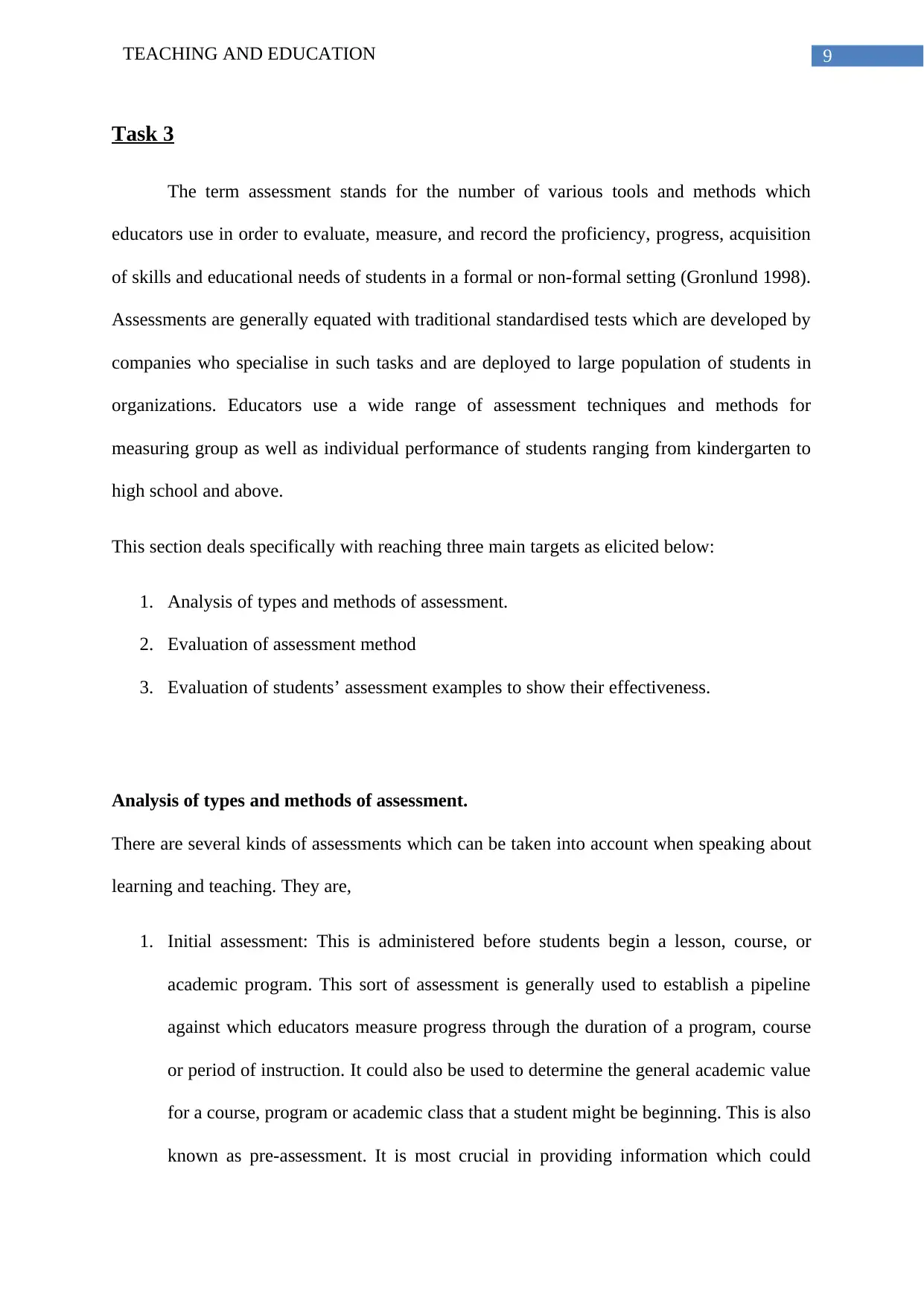
9TEACHING AND EDUCATION
Task 3
The term assessment stands for the number of various tools and methods which
educators use in order to evaluate, measure, and record the proficiency, progress, acquisition
of skills and educational needs of students in a formal or non-formal setting (Gronlund 1998).
Assessments are generally equated with traditional standardised tests which are developed by
companies who specialise in such tasks and are deployed to large population of students in
organizations. Educators use a wide range of assessment techniques and methods for
measuring group as well as individual performance of students ranging from kindergarten to
high school and above.
This section deals specifically with reaching three main targets as elicited below:
1. Analysis of types and methods of assessment.
2. Evaluation of assessment method
3. Evaluation of students’ assessment examples to show their effectiveness.
Analysis of types and methods of assessment.
There are several kinds of assessments which can be taken into account when speaking about
learning and teaching. They are,
1. Initial assessment: This is administered before students begin a lesson, course, or
academic program. This sort of assessment is generally used to establish a pipeline
against which educators measure progress through the duration of a program, course
or period of instruction. It could also be used to determine the general academic value
for a course, program or academic class that a student might be beginning. This is also
known as pre-assessment. It is most crucial in providing information which could
Task 3
The term assessment stands for the number of various tools and methods which
educators use in order to evaluate, measure, and record the proficiency, progress, acquisition
of skills and educational needs of students in a formal or non-formal setting (Gronlund 1998).
Assessments are generally equated with traditional standardised tests which are developed by
companies who specialise in such tasks and are deployed to large population of students in
organizations. Educators use a wide range of assessment techniques and methods for
measuring group as well as individual performance of students ranging from kindergarten to
high school and above.
This section deals specifically with reaching three main targets as elicited below:
1. Analysis of types and methods of assessment.
2. Evaluation of assessment method
3. Evaluation of students’ assessment examples to show their effectiveness.
Analysis of types and methods of assessment.
There are several kinds of assessments which can be taken into account when speaking about
learning and teaching. They are,
1. Initial assessment: This is administered before students begin a lesson, course, or
academic program. This sort of assessment is generally used to establish a pipeline
against which educators measure progress through the duration of a program, course
or period of instruction. It could also be used to determine the general academic value
for a course, program or academic class that a student might be beginning. This is also
known as pre-assessment. It is most crucial in providing information which could
Secure Best Marks with AI Grader
Need help grading? Try our AI Grader for instant feedback on your assignments.
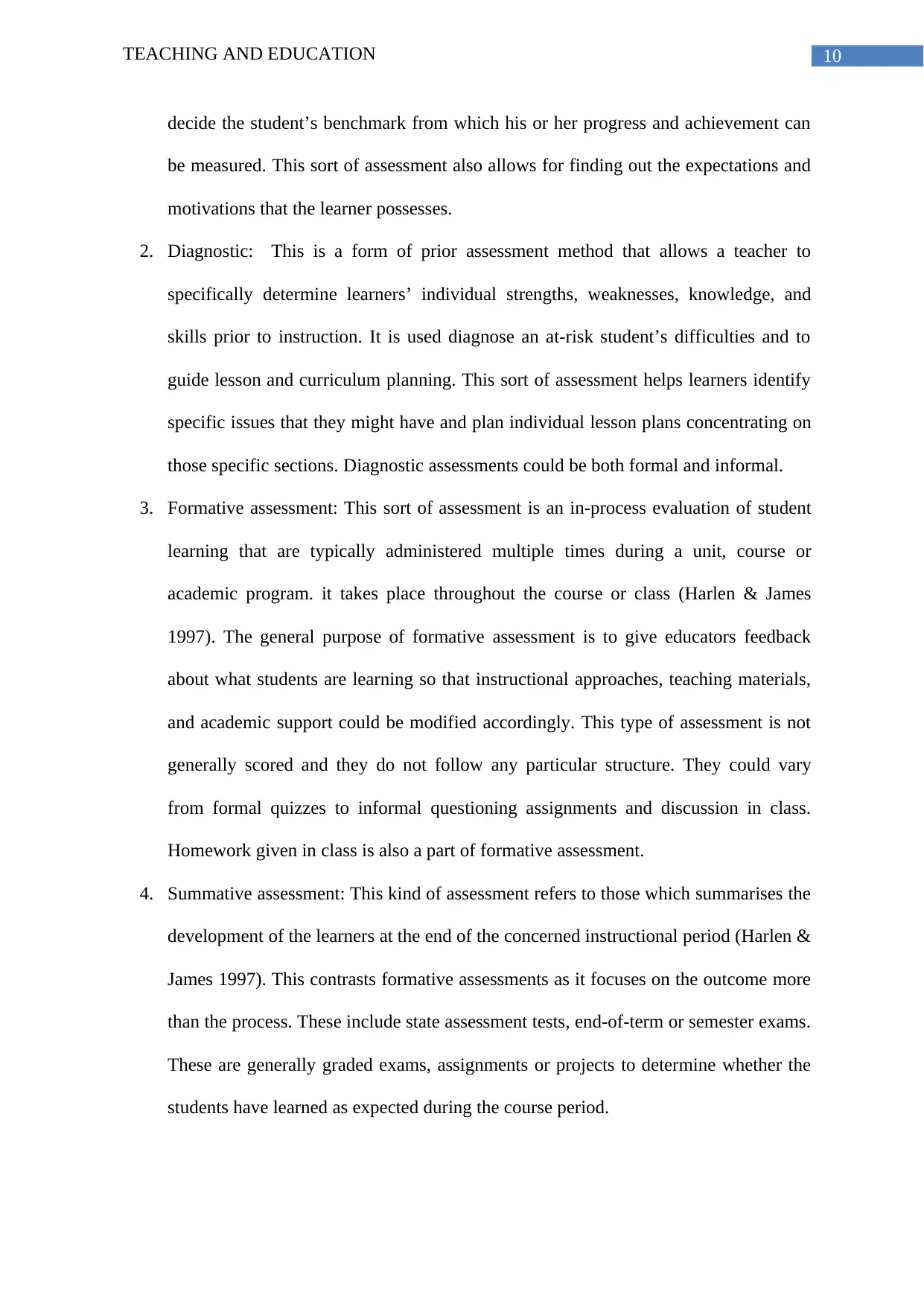
10TEACHING AND EDUCATION
decide the student’s benchmark from which his or her progress and achievement can
be measured. This sort of assessment also allows for finding out the expectations and
motivations that the learner possesses.
2. Diagnostic: This is a form of prior assessment method that allows a teacher to
specifically determine learners’ individual strengths, weaknesses, knowledge, and
skills prior to instruction. It is used diagnose an at-risk student’s difficulties and to
guide lesson and curriculum planning. This sort of assessment helps learners identify
specific issues that they might have and plan individual lesson plans concentrating on
those specific sections. Diagnostic assessments could be both formal and informal.
3. Formative assessment: This sort of assessment is an in-process evaluation of student
learning that are typically administered multiple times during a unit, course or
academic program. it takes place throughout the course or class (Harlen & James
1997). The general purpose of formative assessment is to give educators feedback
about what students are learning so that instructional approaches, teaching materials,
and academic support could be modified accordingly. This type of assessment is not
generally scored and they do not follow any particular structure. They could vary
from formal quizzes to informal questioning assignments and discussion in class.
Homework given in class is also a part of formative assessment.
4. Summative assessment: This kind of assessment refers to those which summarises the
development of the learners at the end of the concerned instructional period (Harlen &
James 1997). This contrasts formative assessments as it focuses on the outcome more
than the process. These include state assessment tests, end-of-term or semester exams.
These are generally graded exams, assignments or projects to determine whether the
students have learned as expected during the course period.
decide the student’s benchmark from which his or her progress and achievement can
be measured. This sort of assessment also allows for finding out the expectations and
motivations that the learner possesses.
2. Diagnostic: This is a form of prior assessment method that allows a teacher to
specifically determine learners’ individual strengths, weaknesses, knowledge, and
skills prior to instruction. It is used diagnose an at-risk student’s difficulties and to
guide lesson and curriculum planning. This sort of assessment helps learners identify
specific issues that they might have and plan individual lesson plans concentrating on
those specific sections. Diagnostic assessments could be both formal and informal.
3. Formative assessment: This sort of assessment is an in-process evaluation of student
learning that are typically administered multiple times during a unit, course or
academic program. it takes place throughout the course or class (Harlen & James
1997). The general purpose of formative assessment is to give educators feedback
about what students are learning so that instructional approaches, teaching materials,
and academic support could be modified accordingly. This type of assessment is not
generally scored and they do not follow any particular structure. They could vary
from formal quizzes to informal questioning assignments and discussion in class.
Homework given in class is also a part of formative assessment.
4. Summative assessment: This kind of assessment refers to those which summarises the
development of the learners at the end of the concerned instructional period (Harlen &
James 1997). This contrasts formative assessments as it focuses on the outcome more
than the process. These include state assessment tests, end-of-term or semester exams.
These are generally graded exams, assignments or projects to determine whether the
students have learned as expected during the course period.
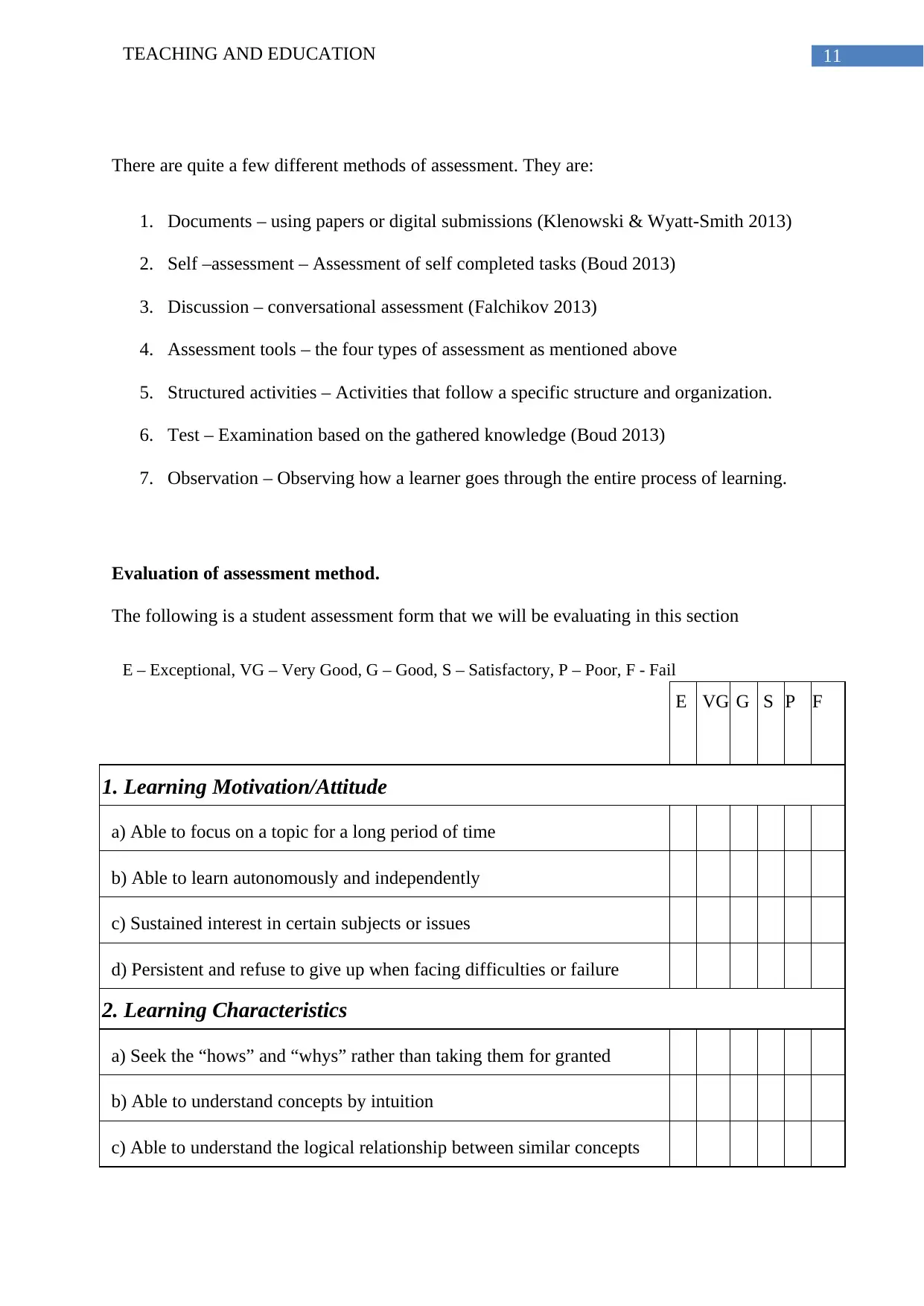
11TEACHING AND EDUCATION
There are quite a few different methods of assessment. They are:
1. Documents – using papers or digital submissions (Klenowski & Wyatt-Smith 2013)
2. Self –assessment – Assessment of self completed tasks (Boud 2013)
3. Discussion – conversational assessment (Falchikov 2013)
4. Assessment tools – the four types of assessment as mentioned above
5. Structured activities – Activities that follow a specific structure and organization.
6. Test – Examination based on the gathered knowledge (Boud 2013)
7. Observation – Observing how a learner goes through the entire process of learning.
Evaluation of assessment method.
The following is a student assessment form that we will be evaluating in this section
E – Exceptional, VG – Very Good, G – Good, S – Satisfactory, P – Poor, F - Fail
E VG G S P F
1. Learning Motivation/Attitude
a) Able to focus on a topic for a long period of time
b) Able to learn autonomously and independently
c) Sustained interest in certain subjects or issues
d) Persistent and refuse to give up when facing difficulties or failure
2. Learning Characteristics
a) Seek the “hows” and “whys” rather than taking them for granted
b) Able to understand concepts by intuition
c) Able to understand the logical relationship between similar concepts
There are quite a few different methods of assessment. They are:
1. Documents – using papers or digital submissions (Klenowski & Wyatt-Smith 2013)
2. Self –assessment – Assessment of self completed tasks (Boud 2013)
3. Discussion – conversational assessment (Falchikov 2013)
4. Assessment tools – the four types of assessment as mentioned above
5. Structured activities – Activities that follow a specific structure and organization.
6. Test – Examination based on the gathered knowledge (Boud 2013)
7. Observation – Observing how a learner goes through the entire process of learning.
Evaluation of assessment method.
The following is a student assessment form that we will be evaluating in this section
E – Exceptional, VG – Very Good, G – Good, S – Satisfactory, P – Poor, F - Fail
E VG G S P F
1. Learning Motivation/Attitude
a) Able to focus on a topic for a long period of time
b) Able to learn autonomously and independently
c) Sustained interest in certain subjects or issues
d) Persistent and refuse to give up when facing difficulties or failure
2. Learning Characteristics
a) Seek the “hows” and “whys” rather than taking them for granted
b) Able to understand concepts by intuition
c) Able to understand the logical relationship between similar concepts
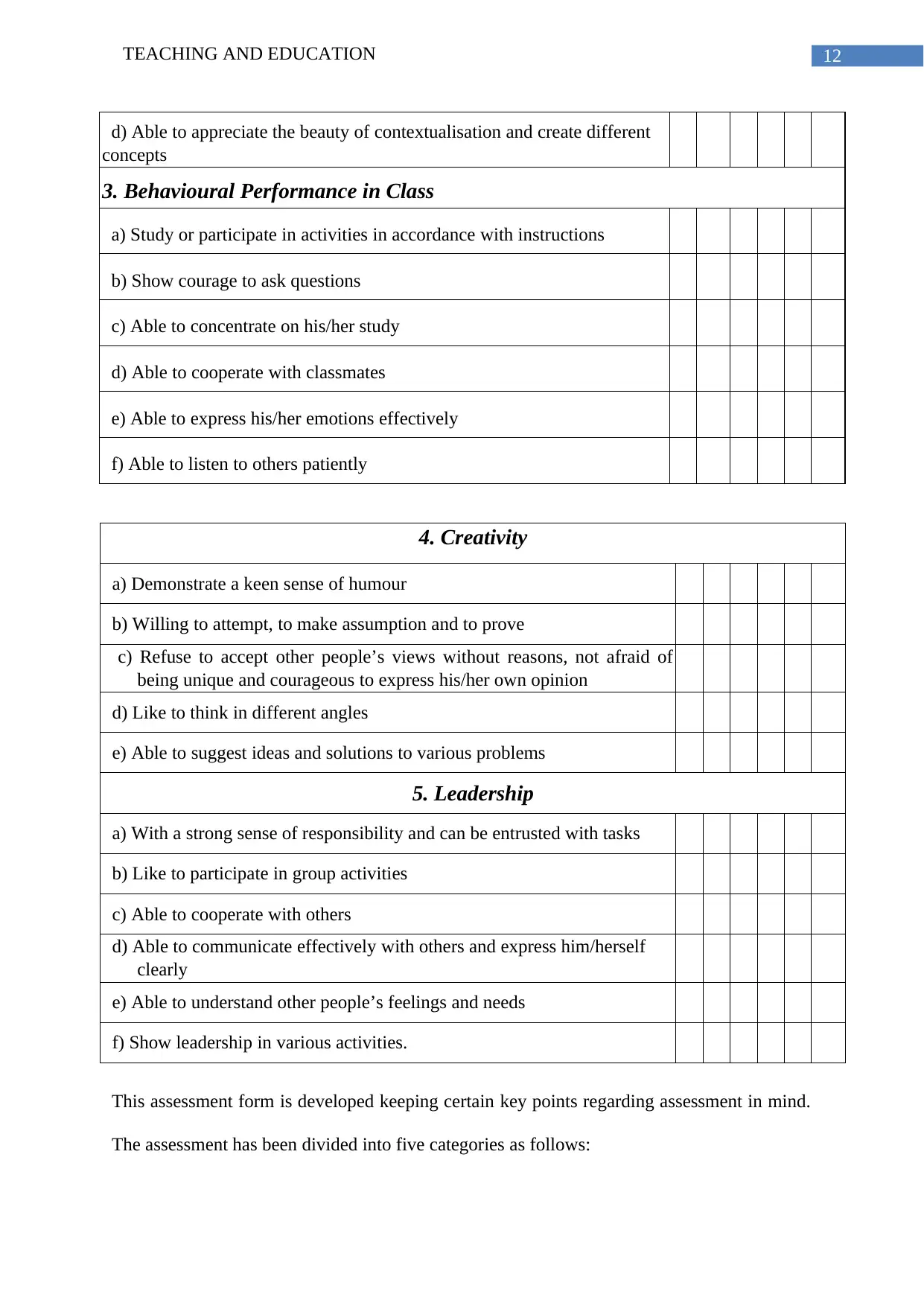
12TEACHING AND EDUCATION
d) Able to appreciate the beauty of contextualisation and create different
concepts
3. Behavioural Performance in Class
a) Study or participate in activities in accordance with instructions
b) Show courage to ask questions
c) Able to concentrate on his/her study
d) Able to cooperate with classmates
e) Able to express his/her emotions effectively
f) Able to listen to others patiently
4. Creativity
a) Demonstrate a keen sense of humour
b) Willing to attempt, to make assumption and to prove
c) Refuse to accept other people’s views without reasons, not afraid of
being unique and courageous to express his/her own opinion
d) Like to think in different angles
e) Able to suggest ideas and solutions to various problems
5. Leadership
a) With a strong sense of responsibility and can be entrusted with tasks
b) Like to participate in group activities
c) Able to cooperate with others
d) Able to communicate effectively with others and express him/herself
clearly
e) Able to understand other people’s feelings and needs
f) Show leadership in various activities.
This assessment form is developed keeping certain key points regarding assessment in mind.
The assessment has been divided into five categories as follows:
d) Able to appreciate the beauty of contextualisation and create different
concepts
3. Behavioural Performance in Class
a) Study or participate in activities in accordance with instructions
b) Show courage to ask questions
c) Able to concentrate on his/her study
d) Able to cooperate with classmates
e) Able to express his/her emotions effectively
f) Able to listen to others patiently
4. Creativity
a) Demonstrate a keen sense of humour
b) Willing to attempt, to make assumption and to prove
c) Refuse to accept other people’s views without reasons, not afraid of
being unique and courageous to express his/her own opinion
d) Like to think in different angles
e) Able to suggest ideas and solutions to various problems
5. Leadership
a) With a strong sense of responsibility and can be entrusted with tasks
b) Like to participate in group activities
c) Able to cooperate with others
d) Able to communicate effectively with others and express him/herself
clearly
e) Able to understand other people’s feelings and needs
f) Show leadership in various activities.
This assessment form is developed keeping certain key points regarding assessment in mind.
The assessment has been divided into five categories as follows:
Paraphrase This Document
Need a fresh take? Get an instant paraphrase of this document with our AI Paraphraser
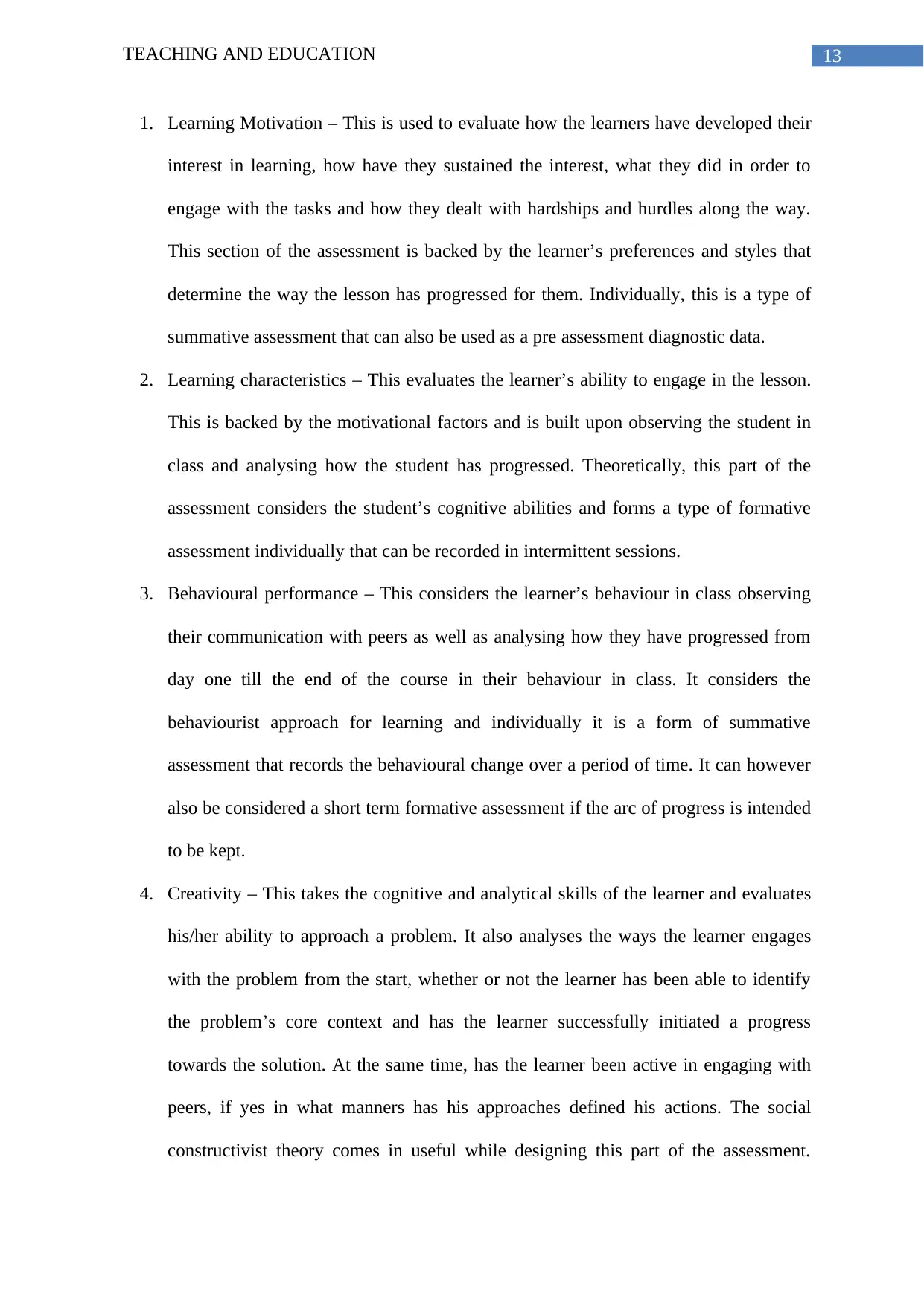
13TEACHING AND EDUCATION
1. Learning Motivation – This is used to evaluate how the learners have developed their
interest in learning, how have they sustained the interest, what they did in order to
engage with the tasks and how they dealt with hardships and hurdles along the way.
This section of the assessment is backed by the learner’s preferences and styles that
determine the way the lesson has progressed for them. Individually, this is a type of
summative assessment that can also be used as a pre assessment diagnostic data.
2. Learning characteristics – This evaluates the learner’s ability to engage in the lesson.
This is backed by the motivational factors and is built upon observing the student in
class and analysing how the student has progressed. Theoretically, this part of the
assessment considers the student’s cognitive abilities and forms a type of formative
assessment individually that can be recorded in intermittent sessions.
3. Behavioural performance – This considers the learner’s behaviour in class observing
their communication with peers as well as analysing how they have progressed from
day one till the end of the course in their behaviour in class. It considers the
behaviourist approach for learning and individually it is a form of summative
assessment that records the behavioural change over a period of time. It can however
also be considered a short term formative assessment if the arc of progress is intended
to be kept.
4. Creativity – This takes the cognitive and analytical skills of the learner and evaluates
his/her ability to approach a problem. It also analyses the ways the learner engages
with the problem from the start, whether or not the learner has been able to identify
the problem’s core context and has the learner successfully initiated a progress
towards the solution. At the same time, has the learner been active in engaging with
peers, if yes in what manners has his approaches defined his actions. The social
constructivist theory comes in useful while designing this part of the assessment.
1. Learning Motivation – This is used to evaluate how the learners have developed their
interest in learning, how have they sustained the interest, what they did in order to
engage with the tasks and how they dealt with hardships and hurdles along the way.
This section of the assessment is backed by the learner’s preferences and styles that
determine the way the lesson has progressed for them. Individually, this is a type of
summative assessment that can also be used as a pre assessment diagnostic data.
2. Learning characteristics – This evaluates the learner’s ability to engage in the lesson.
This is backed by the motivational factors and is built upon observing the student in
class and analysing how the student has progressed. Theoretically, this part of the
assessment considers the student’s cognitive abilities and forms a type of formative
assessment individually that can be recorded in intermittent sessions.
3. Behavioural performance – This considers the learner’s behaviour in class observing
their communication with peers as well as analysing how they have progressed from
day one till the end of the course in their behaviour in class. It considers the
behaviourist approach for learning and individually it is a form of summative
assessment that records the behavioural change over a period of time. It can however
also be considered a short term formative assessment if the arc of progress is intended
to be kept.
4. Creativity – This takes the cognitive and analytical skills of the learner and evaluates
his/her ability to approach a problem. It also analyses the ways the learner engages
with the problem from the start, whether or not the learner has been able to identify
the problem’s core context and has the learner successfully initiated a progress
towards the solution. At the same time, has the learner been active in engaging with
peers, if yes in what manners has his approaches defined his actions. The social
constructivist theory comes in useful while designing this part of the assessment.
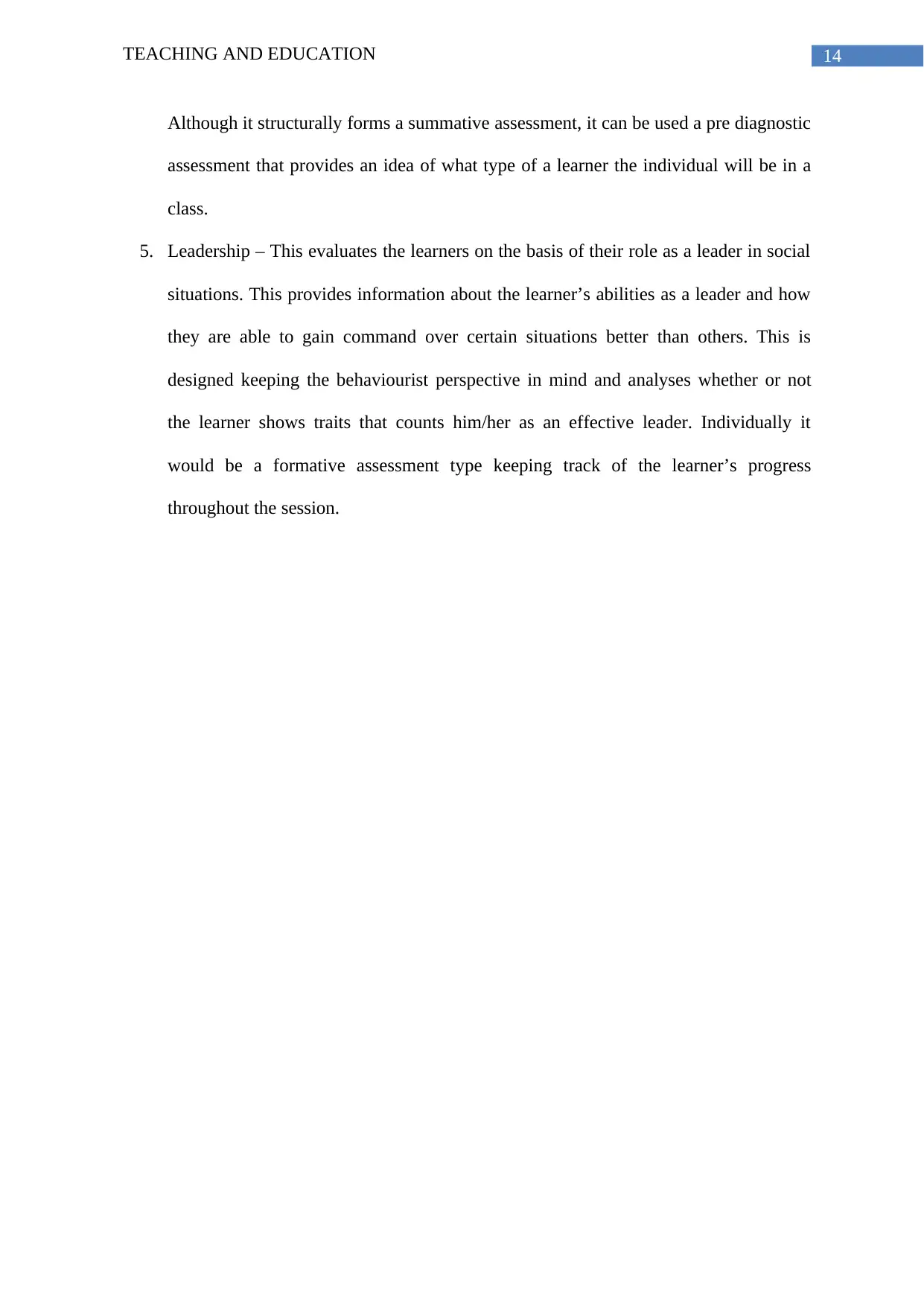
14TEACHING AND EDUCATION
Although it structurally forms a summative assessment, it can be used a pre diagnostic
assessment that provides an idea of what type of a learner the individual will be in a
class.
5. Leadership – This evaluates the learners on the basis of their role as a leader in social
situations. This provides information about the learner’s abilities as a leader and how
they are able to gain command over certain situations better than others. This is
designed keeping the behaviourist perspective in mind and analyses whether or not
the learner shows traits that counts him/her as an effective leader. Individually it
would be a formative assessment type keeping track of the learner’s progress
throughout the session.
Although it structurally forms a summative assessment, it can be used a pre diagnostic
assessment that provides an idea of what type of a learner the individual will be in a
class.
5. Leadership – This evaluates the learners on the basis of their role as a leader in social
situations. This provides information about the learner’s abilities as a leader and how
they are able to gain command over certain situations better than others. This is
designed keeping the behaviourist perspective in mind and analyses whether or not
the learner shows traits that counts him/her as an effective leader. Individually it
would be a formative assessment type keeping track of the learner’s progress
throughout the session.
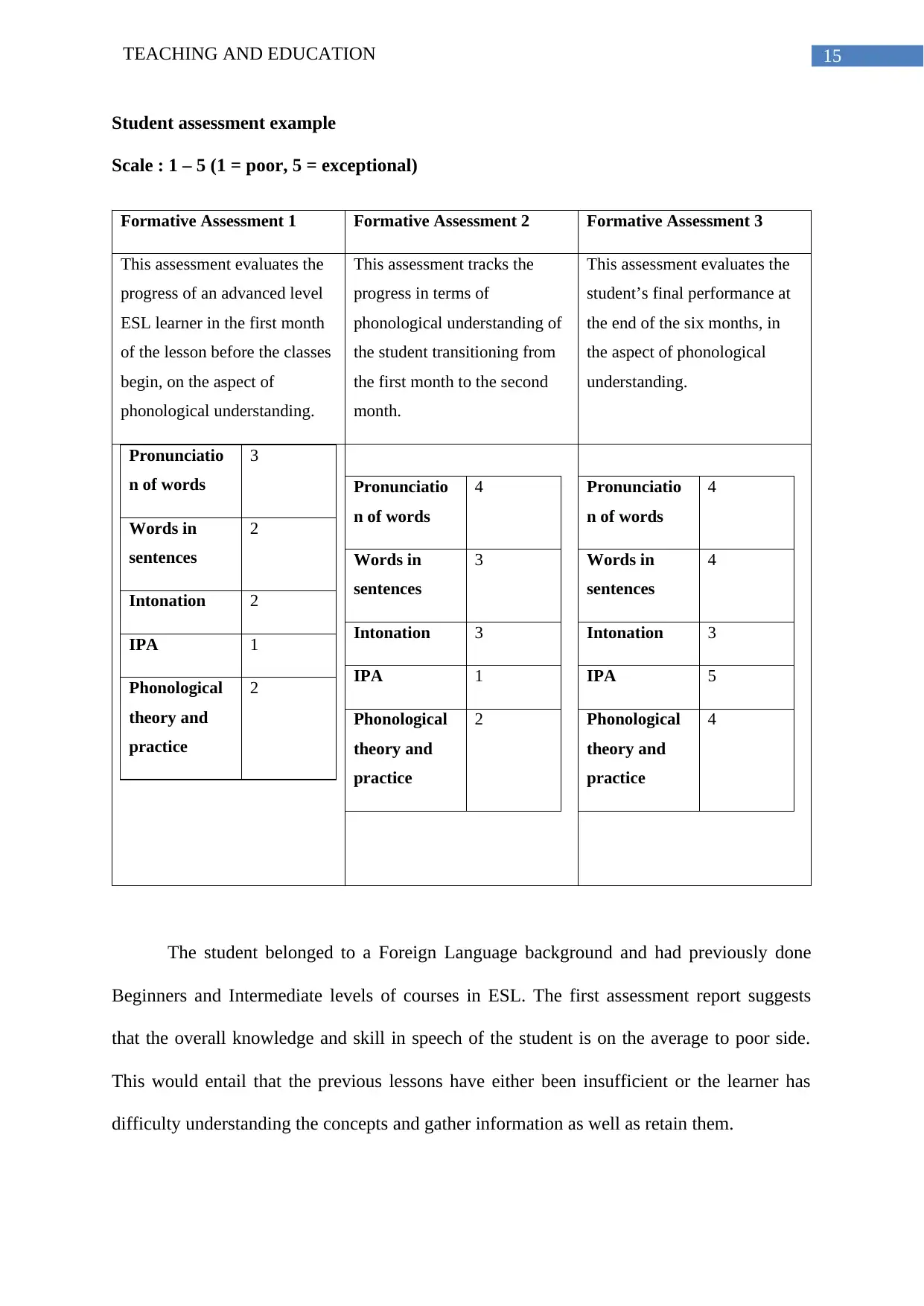
15TEACHING AND EDUCATION
Student assessment example
Scale : 1 – 5 (1 = poor, 5 = exceptional)
Formative Assessment 1 Formative Assessment 2 Formative Assessment 3
This assessment evaluates the
progress of an advanced level
ESL learner in the first month
of the lesson before the classes
begin, on the aspect of
phonological understanding.
This assessment tracks the
progress in terms of
phonological understanding of
the student transitioning from
the first month to the second
month.
This assessment evaluates the
student’s final performance at
the end of the six months, in
the aspect of phonological
understanding.
Pronunciatio
n of words
3
Words in
sentences
2
Intonation 2
IPA 1
Phonological
theory and
practice
2
The student belonged to a Foreign Language background and had previously done
Beginners and Intermediate levels of courses in ESL. The first assessment report suggests
that the overall knowledge and skill in speech of the student is on the average to poor side.
This would entail that the previous lessons have either been insufficient or the learner has
difficulty understanding the concepts and gather information as well as retain them.
Pronunciatio
n of words
4
Words in
sentences
3
Intonation 3
IPA 1
Phonological
theory and
practice
2
Pronunciatio
n of words
4
Words in
sentences
4
Intonation 3
IPA 5
Phonological
theory and
practice
4
Student assessment example
Scale : 1 – 5 (1 = poor, 5 = exceptional)
Formative Assessment 1 Formative Assessment 2 Formative Assessment 3
This assessment evaluates the
progress of an advanced level
ESL learner in the first month
of the lesson before the classes
begin, on the aspect of
phonological understanding.
This assessment tracks the
progress in terms of
phonological understanding of
the student transitioning from
the first month to the second
month.
This assessment evaluates the
student’s final performance at
the end of the six months, in
the aspect of phonological
understanding.
Pronunciatio
n of words
3
Words in
sentences
2
Intonation 2
IPA 1
Phonological
theory and
practice
2
The student belonged to a Foreign Language background and had previously done
Beginners and Intermediate levels of courses in ESL. The first assessment report suggests
that the overall knowledge and skill in speech of the student is on the average to poor side.
This would entail that the previous lessons have either been insufficient or the learner has
difficulty understanding the concepts and gather information as well as retain them.
Pronunciatio
n of words
4
Words in
sentences
3
Intonation 3
IPA 1
Phonological
theory and
practice
2
Pronunciatio
n of words
4
Words in
sentences
4
Intonation 3
IPA 5
Phonological
theory and
practice
4
Secure Best Marks with AI Grader
Need help grading? Try our AI Grader for instant feedback on your assignments.
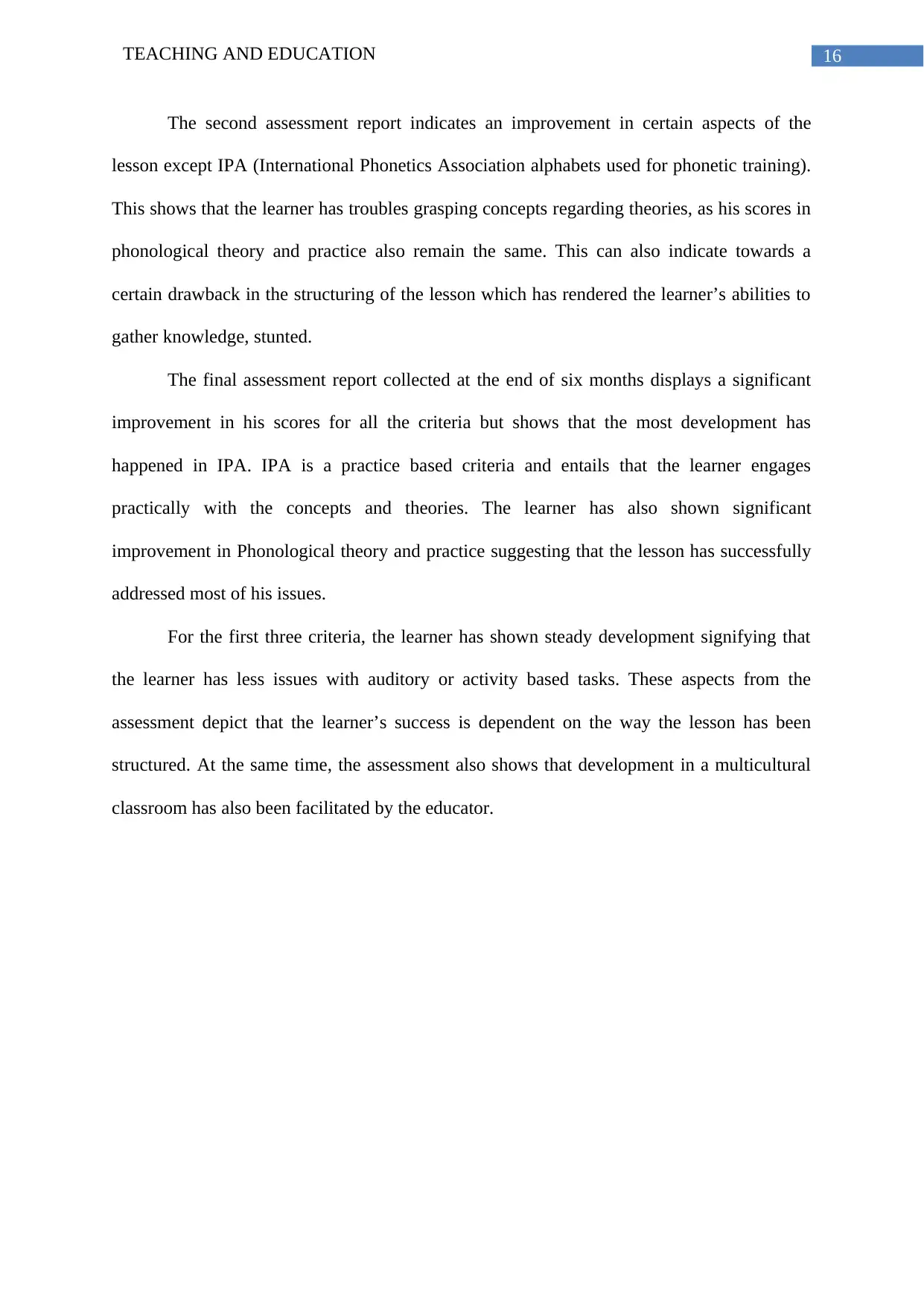
16TEACHING AND EDUCATION
The second assessment report indicates an improvement in certain aspects of the
lesson except IPA (International Phonetics Association alphabets used for phonetic training).
This shows that the learner has troubles grasping concepts regarding theories, as his scores in
phonological theory and practice also remain the same. This can also indicate towards a
certain drawback in the structuring of the lesson which has rendered the learner’s abilities to
gather knowledge, stunted.
The final assessment report collected at the end of six months displays a significant
improvement in his scores for all the criteria but shows that the most development has
happened in IPA. IPA is a practice based criteria and entails that the learner engages
practically with the concepts and theories. The learner has also shown significant
improvement in Phonological theory and practice suggesting that the lesson has successfully
addressed most of his issues.
For the first three criteria, the learner has shown steady development signifying that
the learner has less issues with auditory or activity based tasks. These aspects from the
assessment depict that the learner’s success is dependent on the way the lesson has been
structured. At the same time, the assessment also shows that development in a multicultural
classroom has also been facilitated by the educator.
The second assessment report indicates an improvement in certain aspects of the
lesson except IPA (International Phonetics Association alphabets used for phonetic training).
This shows that the learner has troubles grasping concepts regarding theories, as his scores in
phonological theory and practice also remain the same. This can also indicate towards a
certain drawback in the structuring of the lesson which has rendered the learner’s abilities to
gather knowledge, stunted.
The final assessment report collected at the end of six months displays a significant
improvement in his scores for all the criteria but shows that the most development has
happened in IPA. IPA is a practice based criteria and entails that the learner engages
practically with the concepts and theories. The learner has also shown significant
improvement in Phonological theory and practice suggesting that the lesson has successfully
addressed most of his issues.
For the first three criteria, the learner has shown steady development signifying that
the learner has less issues with auditory or activity based tasks. These aspects from the
assessment depict that the learner’s success is dependent on the way the lesson has been
structured. At the same time, the assessment also shows that development in a multicultural
classroom has also been facilitated by the educator.
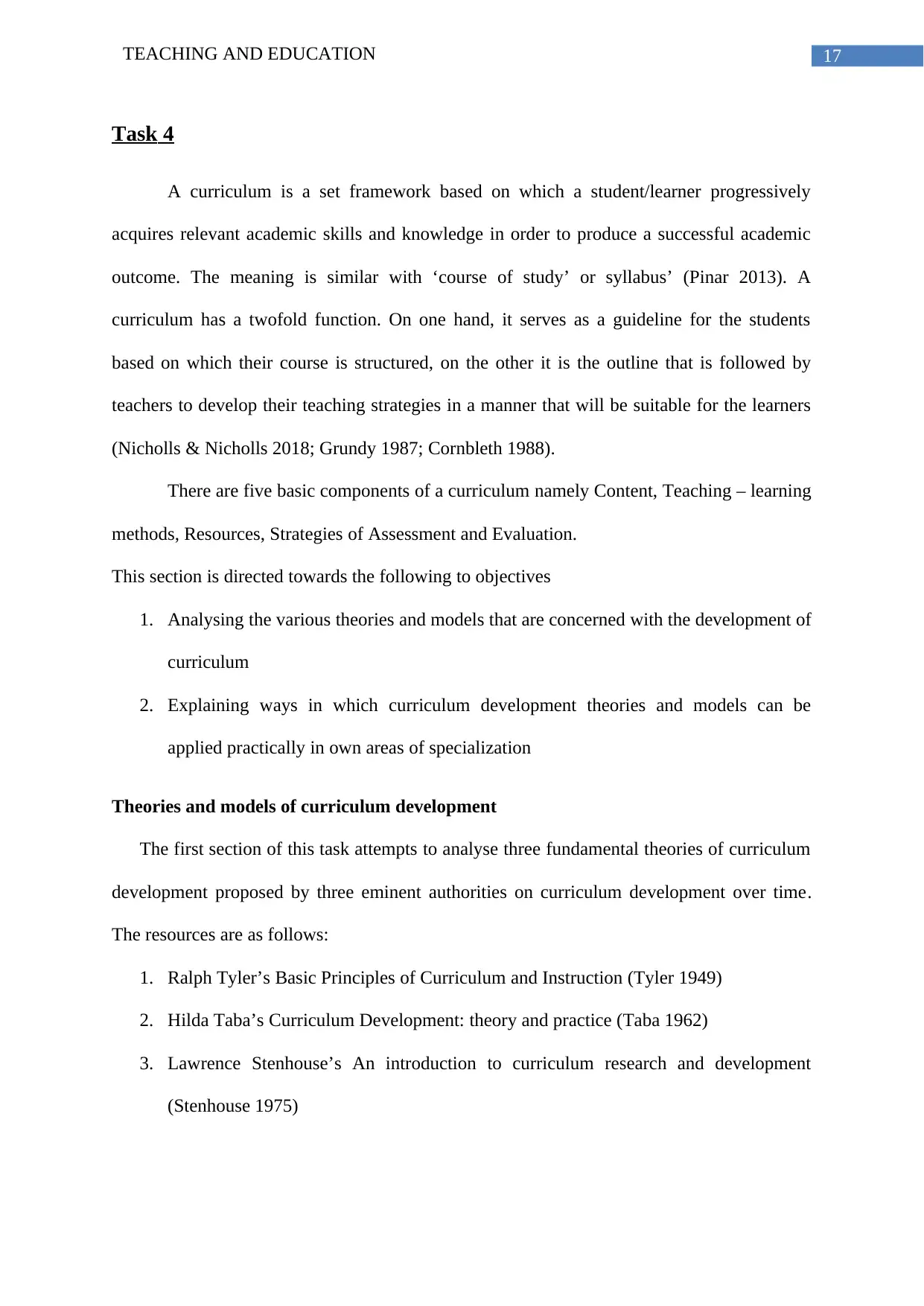
17TEACHING AND EDUCATION
Task 4
A curriculum is a set framework based on which a student/learner progressively
acquires relevant academic skills and knowledge in order to produce a successful academic
outcome. The meaning is similar with ‘course of study’ or syllabus’ (Pinar 2013). A
curriculum has a twofold function. On one hand, it serves as a guideline for the students
based on which their course is structured, on the other it is the outline that is followed by
teachers to develop their teaching strategies in a manner that will be suitable for the learners
(Nicholls & Nicholls 2018; Grundy 1987; Cornbleth 1988).
There are five basic components of a curriculum namely Content, Teaching – learning
methods, Resources, Strategies of Assessment and Evaluation.
This section is directed towards the following to objectives
1. Analysing the various theories and models that are concerned with the development of
curriculum
2. Explaining ways in which curriculum development theories and models can be
applied practically in own areas of specialization
Theories and models of curriculum development
The first section of this task attempts to analyse three fundamental theories of curriculum
development proposed by three eminent authorities on curriculum development over time.
The resources are as follows:
1. Ralph Tyler’s Basic Principles of Curriculum and Instruction (Tyler 1949)
2. Hilda Taba’s Curriculum Development: theory and practice (Taba 1962)
3. Lawrence Stenhouse’s An introduction to curriculum research and development
(Stenhouse 1975)
Task 4
A curriculum is a set framework based on which a student/learner progressively
acquires relevant academic skills and knowledge in order to produce a successful academic
outcome. The meaning is similar with ‘course of study’ or syllabus’ (Pinar 2013). A
curriculum has a twofold function. On one hand, it serves as a guideline for the students
based on which their course is structured, on the other it is the outline that is followed by
teachers to develop their teaching strategies in a manner that will be suitable for the learners
(Nicholls & Nicholls 2018; Grundy 1987; Cornbleth 1988).
There are five basic components of a curriculum namely Content, Teaching – learning
methods, Resources, Strategies of Assessment and Evaluation.
This section is directed towards the following to objectives
1. Analysing the various theories and models that are concerned with the development of
curriculum
2. Explaining ways in which curriculum development theories and models can be
applied practically in own areas of specialization
Theories and models of curriculum development
The first section of this task attempts to analyse three fundamental theories of curriculum
development proposed by three eminent authorities on curriculum development over time.
The resources are as follows:
1. Ralph Tyler’s Basic Principles of Curriculum and Instruction (Tyler 1949)
2. Hilda Taba’s Curriculum Development: theory and practice (Taba 1962)
3. Lawrence Stenhouse’s An introduction to curriculum research and development
(Stenhouse 1975)
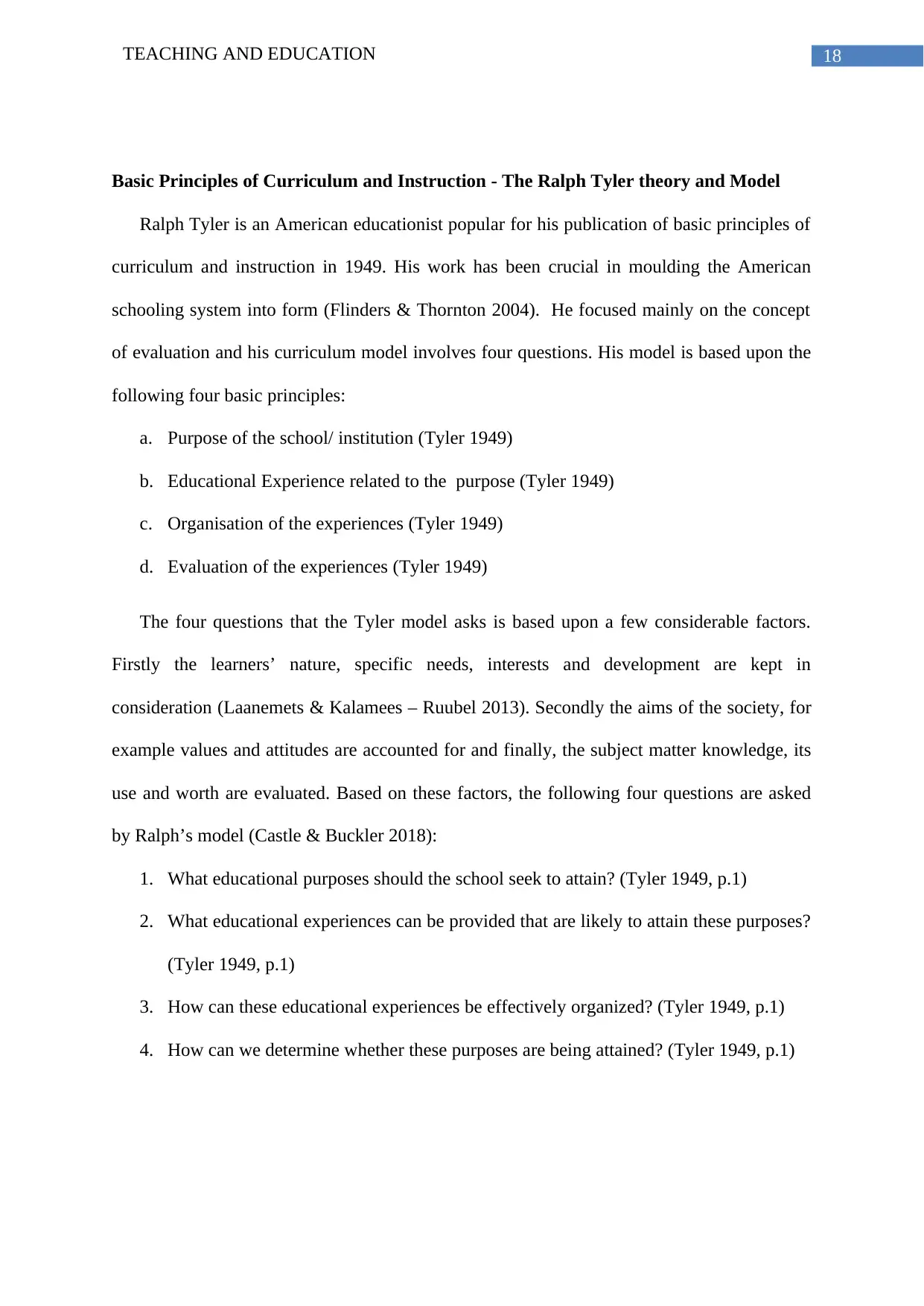
18TEACHING AND EDUCATION
Basic Principles of Curriculum and Instruction - The Ralph Tyler theory and Model
Ralph Tyler is an American educationist popular for his publication of basic principles of
curriculum and instruction in 1949. His work has been crucial in moulding the American
schooling system into form (Flinders & Thornton 2004). He focused mainly on the concept
of evaluation and his curriculum model involves four questions. His model is based upon the
following four basic principles:
a. Purpose of the school/ institution (Tyler 1949)
b. Educational Experience related to the purpose (Tyler 1949)
c. Organisation of the experiences (Tyler 1949)
d. Evaluation of the experiences (Tyler 1949)
The four questions that the Tyler model asks is based upon a few considerable factors.
Firstly the learners’ nature, specific needs, interests and development are kept in
consideration (Laanemets & Kalamees – Ruubel 2013). Secondly the aims of the society, for
example values and attitudes are accounted for and finally, the subject matter knowledge, its
use and worth are evaluated. Based on these factors, the following four questions are asked
by Ralph’s model (Castle & Buckler 2018):
1. What educational purposes should the school seek to attain? (Tyler 1949, p.1)
2. What educational experiences can be provided that are likely to attain these purposes?
(Tyler 1949, p.1)
3. How can these educational experiences be effectively organized? (Tyler 1949, p.1)
4. How can we determine whether these purposes are being attained? (Tyler 1949, p.1)
Basic Principles of Curriculum and Instruction - The Ralph Tyler theory and Model
Ralph Tyler is an American educationist popular for his publication of basic principles of
curriculum and instruction in 1949. His work has been crucial in moulding the American
schooling system into form (Flinders & Thornton 2004). He focused mainly on the concept
of evaluation and his curriculum model involves four questions. His model is based upon the
following four basic principles:
a. Purpose of the school/ institution (Tyler 1949)
b. Educational Experience related to the purpose (Tyler 1949)
c. Organisation of the experiences (Tyler 1949)
d. Evaluation of the experiences (Tyler 1949)
The four questions that the Tyler model asks is based upon a few considerable factors.
Firstly the learners’ nature, specific needs, interests and development are kept in
consideration (Laanemets & Kalamees – Ruubel 2013). Secondly the aims of the society, for
example values and attitudes are accounted for and finally, the subject matter knowledge, its
use and worth are evaluated. Based on these factors, the following four questions are asked
by Ralph’s model (Castle & Buckler 2018):
1. What educational purposes should the school seek to attain? (Tyler 1949, p.1)
2. What educational experiences can be provided that are likely to attain these purposes?
(Tyler 1949, p.1)
3. How can these educational experiences be effectively organized? (Tyler 1949, p.1)
4. How can we determine whether these purposes are being attained? (Tyler 1949, p.1)
Paraphrase This Document
Need a fresh take? Get an instant paraphrase of this document with our AI Paraphraser
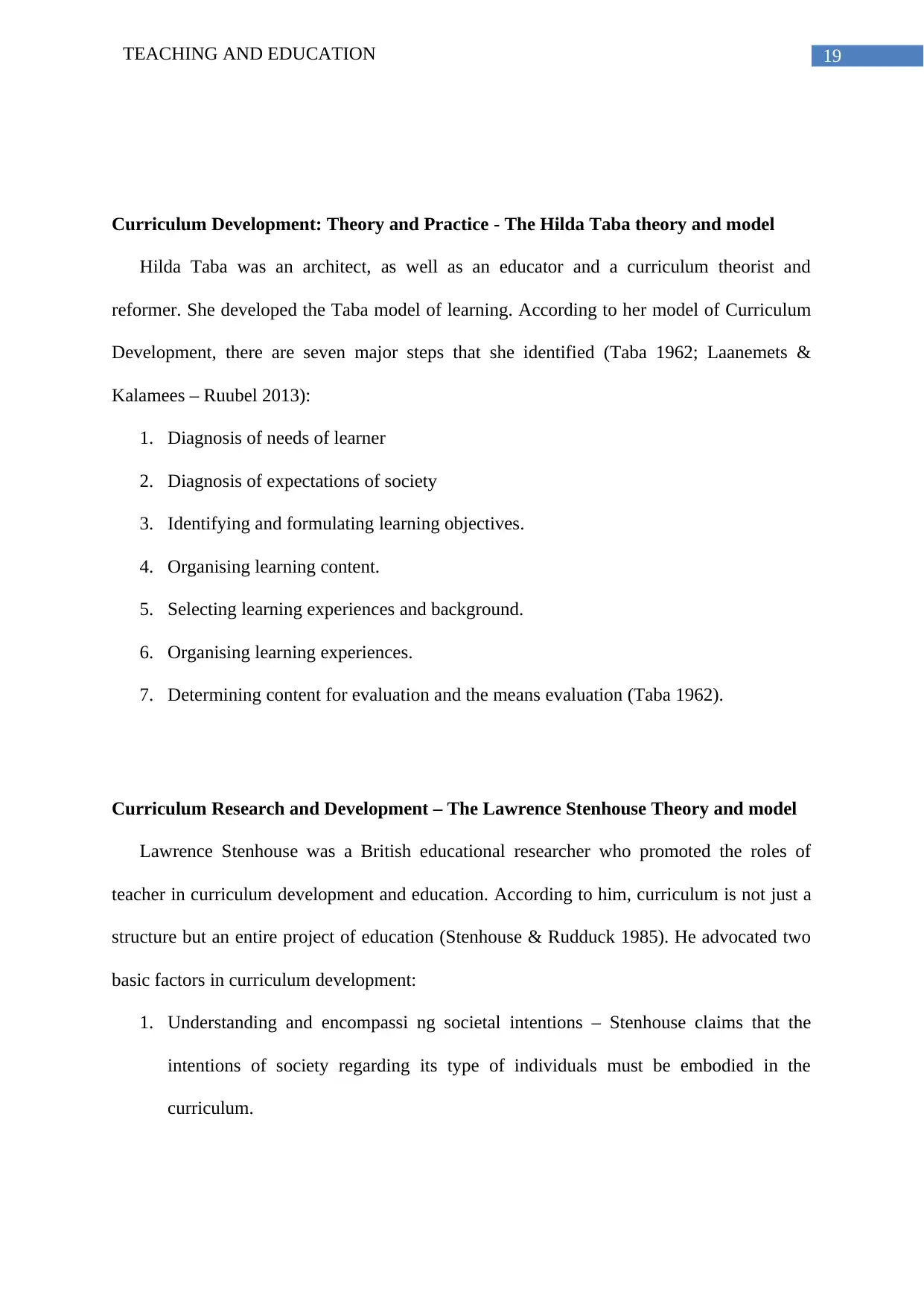
19TEACHING AND EDUCATION
Curriculum Development: Theory and Practice - The Hilda Taba theory and model
Hilda Taba was an architect, as well as an educator and a curriculum theorist and
reformer. She developed the Taba model of learning. According to her model of Curriculum
Development, there are seven major steps that she identified (Taba 1962; Laanemets &
Kalamees – Ruubel 2013):
1. Diagnosis of needs of learner
2. Diagnosis of expectations of society
3. Identifying and formulating learning objectives.
4. Organising learning content.
5. Selecting learning experiences and background.
6. Organising learning experiences.
7. Determining content for evaluation and the means evaluation (Taba 1962).
Curriculum Research and Development – The Lawrence Stenhouse Theory and model
Lawrence Stenhouse was a British educational researcher who promoted the roles of
teacher in curriculum development and education. According to him, curriculum is not just a
structure but an entire project of education (Stenhouse & Rudduck 1985). He advocated two
basic factors in curriculum development:
1. Understanding and encompassi ng societal intentions – Stenhouse claims that the
intentions of society regarding its type of individuals must be embodied in the
curriculum.
Curriculum Development: Theory and Practice - The Hilda Taba theory and model
Hilda Taba was an architect, as well as an educator and a curriculum theorist and
reformer. She developed the Taba model of learning. According to her model of Curriculum
Development, there are seven major steps that she identified (Taba 1962; Laanemets &
Kalamees – Ruubel 2013):
1. Diagnosis of needs of learner
2. Diagnosis of expectations of society
3. Identifying and formulating learning objectives.
4. Organising learning content.
5. Selecting learning experiences and background.
6. Organising learning experiences.
7. Determining content for evaluation and the means evaluation (Taba 1962).
Curriculum Research and Development – The Lawrence Stenhouse Theory and model
Lawrence Stenhouse was a British educational researcher who promoted the roles of
teacher in curriculum development and education. According to him, curriculum is not just a
structure but an entire project of education (Stenhouse & Rudduck 1985). He advocated two
basic factors in curriculum development:
1. Understanding and encompassi ng societal intentions – Stenhouse claims that the
intentions of society regarding its type of individuals must be embodied in the
curriculum.
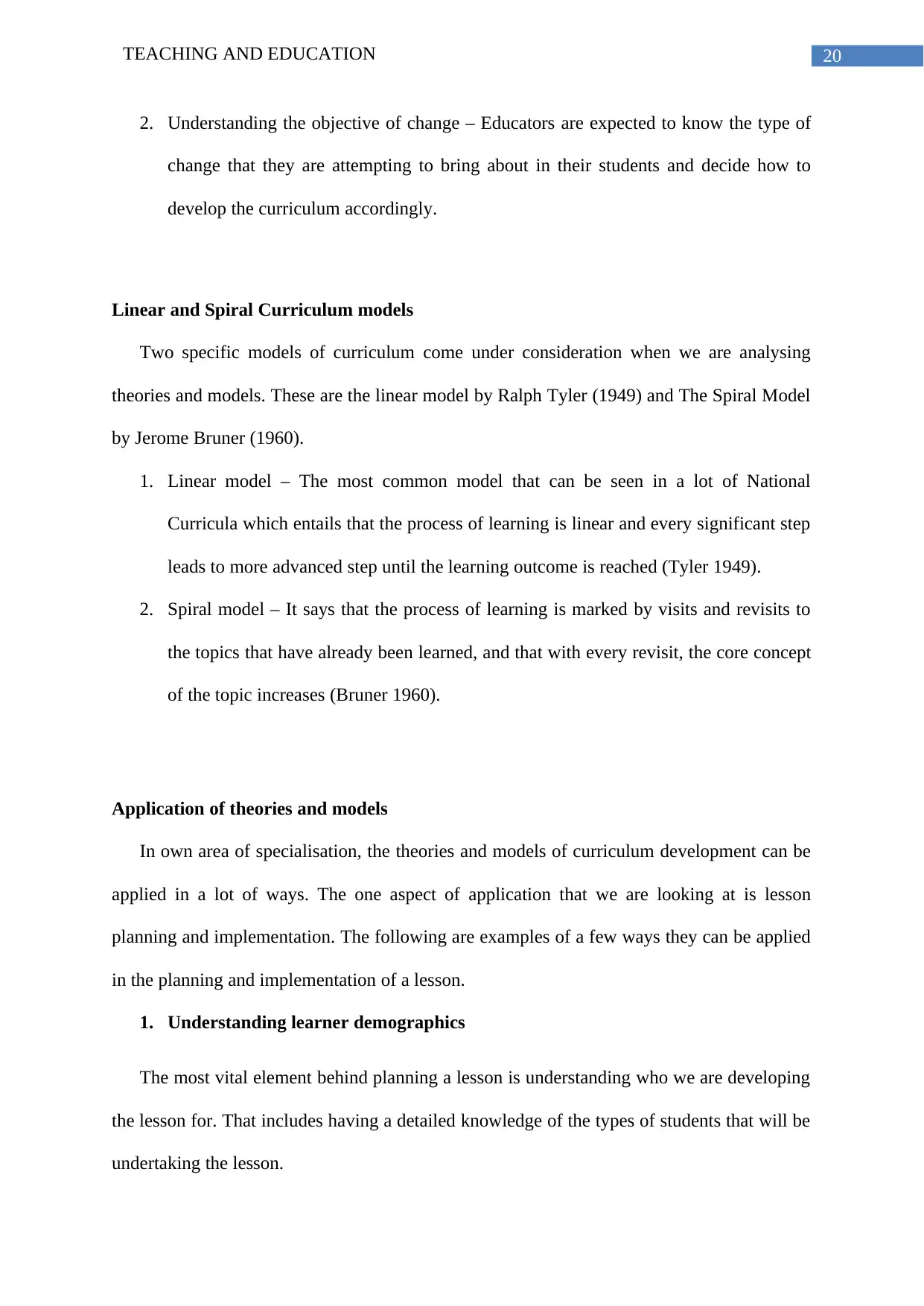
20TEACHING AND EDUCATION
2. Understanding the objective of change – Educators are expected to know the type of
change that they are attempting to bring about in their students and decide how to
develop the curriculum accordingly.
Linear and Spiral Curriculum models
Two specific models of curriculum come under consideration when we are analysing
theories and models. These are the linear model by Ralph Tyler (1949) and The Spiral Model
by Jerome Bruner (1960).
1. Linear model – The most common model that can be seen in a lot of National
Curricula which entails that the process of learning is linear and every significant step
leads to more advanced step until the learning outcome is reached (Tyler 1949).
2. Spiral model – It says that the process of learning is marked by visits and revisits to
the topics that have already been learned, and that with every revisit, the core concept
of the topic increases (Bruner 1960).
Application of theories and models
In own area of specialisation, the theories and models of curriculum development can be
applied in a lot of ways. The one aspect of application that we are looking at is lesson
planning and implementation. The following are examples of a few ways they can be applied
in the planning and implementation of a lesson.
1. Understanding learner demographics
The most vital element behind planning a lesson is understanding who we are developing
the lesson for. That includes having a detailed knowledge of the types of students that will be
undertaking the lesson.
2. Understanding the objective of change – Educators are expected to know the type of
change that they are attempting to bring about in their students and decide how to
develop the curriculum accordingly.
Linear and Spiral Curriculum models
Two specific models of curriculum come under consideration when we are analysing
theories and models. These are the linear model by Ralph Tyler (1949) and The Spiral Model
by Jerome Bruner (1960).
1. Linear model – The most common model that can be seen in a lot of National
Curricula which entails that the process of learning is linear and every significant step
leads to more advanced step until the learning outcome is reached (Tyler 1949).
2. Spiral model – It says that the process of learning is marked by visits and revisits to
the topics that have already been learned, and that with every revisit, the core concept
of the topic increases (Bruner 1960).
Application of theories and models
In own area of specialisation, the theories and models of curriculum development can be
applied in a lot of ways. The one aspect of application that we are looking at is lesson
planning and implementation. The following are examples of a few ways they can be applied
in the planning and implementation of a lesson.
1. Understanding learner demographics
The most vital element behind planning a lesson is understanding who we are developing
the lesson for. That includes having a detailed knowledge of the types of students that will be
undertaking the lesson.
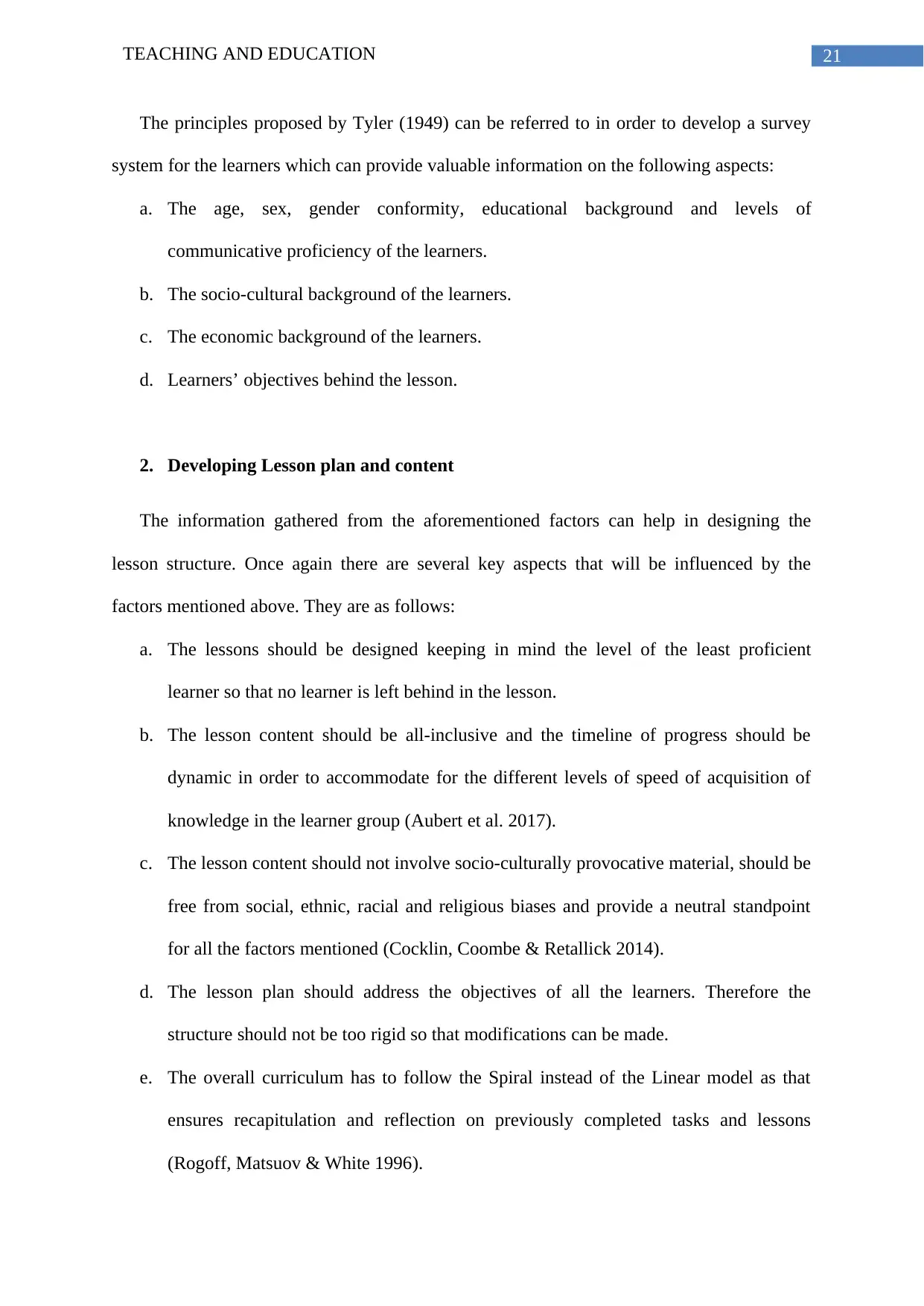
21TEACHING AND EDUCATION
The principles proposed by Tyler (1949) can be referred to in order to develop a survey
system for the learners which can provide valuable information on the following aspects:
a. The age, sex, gender conformity, educational background and levels of
communicative proficiency of the learners.
b. The socio-cultural background of the learners.
c. The economic background of the learners.
d. Learners’ objectives behind the lesson.
2. Developing Lesson plan and content
The information gathered from the aforementioned factors can help in designing the
lesson structure. Once again there are several key aspects that will be influenced by the
factors mentioned above. They are as follows:
a. The lessons should be designed keeping in mind the level of the least proficient
learner so that no learner is left behind in the lesson.
b. The lesson content should be all-inclusive and the timeline of progress should be
dynamic in order to accommodate for the different levels of speed of acquisition of
knowledge in the learner group (Aubert et al. 2017).
c. The lesson content should not involve socio-culturally provocative material, should be
free from social, ethnic, racial and religious biases and provide a neutral standpoint
for all the factors mentioned (Cocklin, Coombe & Retallick 2014).
d. The lesson plan should address the objectives of all the learners. Therefore the
structure should not be too rigid so that modifications can be made.
e. The overall curriculum has to follow the Spiral instead of the Linear model as that
ensures recapitulation and reflection on previously completed tasks and lessons
(Rogoff, Matsuov & White 1996).
The principles proposed by Tyler (1949) can be referred to in order to develop a survey
system for the learners which can provide valuable information on the following aspects:
a. The age, sex, gender conformity, educational background and levels of
communicative proficiency of the learners.
b. The socio-cultural background of the learners.
c. The economic background of the learners.
d. Learners’ objectives behind the lesson.
2. Developing Lesson plan and content
The information gathered from the aforementioned factors can help in designing the
lesson structure. Once again there are several key aspects that will be influenced by the
factors mentioned above. They are as follows:
a. The lessons should be designed keeping in mind the level of the least proficient
learner so that no learner is left behind in the lesson.
b. The lesson content should be all-inclusive and the timeline of progress should be
dynamic in order to accommodate for the different levels of speed of acquisition of
knowledge in the learner group (Aubert et al. 2017).
c. The lesson content should not involve socio-culturally provocative material, should be
free from social, ethnic, racial and religious biases and provide a neutral standpoint
for all the factors mentioned (Cocklin, Coombe & Retallick 2014).
d. The lesson plan should address the objectives of all the learners. Therefore the
structure should not be too rigid so that modifications can be made.
e. The overall curriculum has to follow the Spiral instead of the Linear model as that
ensures recapitulation and reflection on previously completed tasks and lessons
(Rogoff, Matsuov & White 1996).
Secure Best Marks with AI Grader
Need help grading? Try our AI Grader for instant feedback on your assignments.
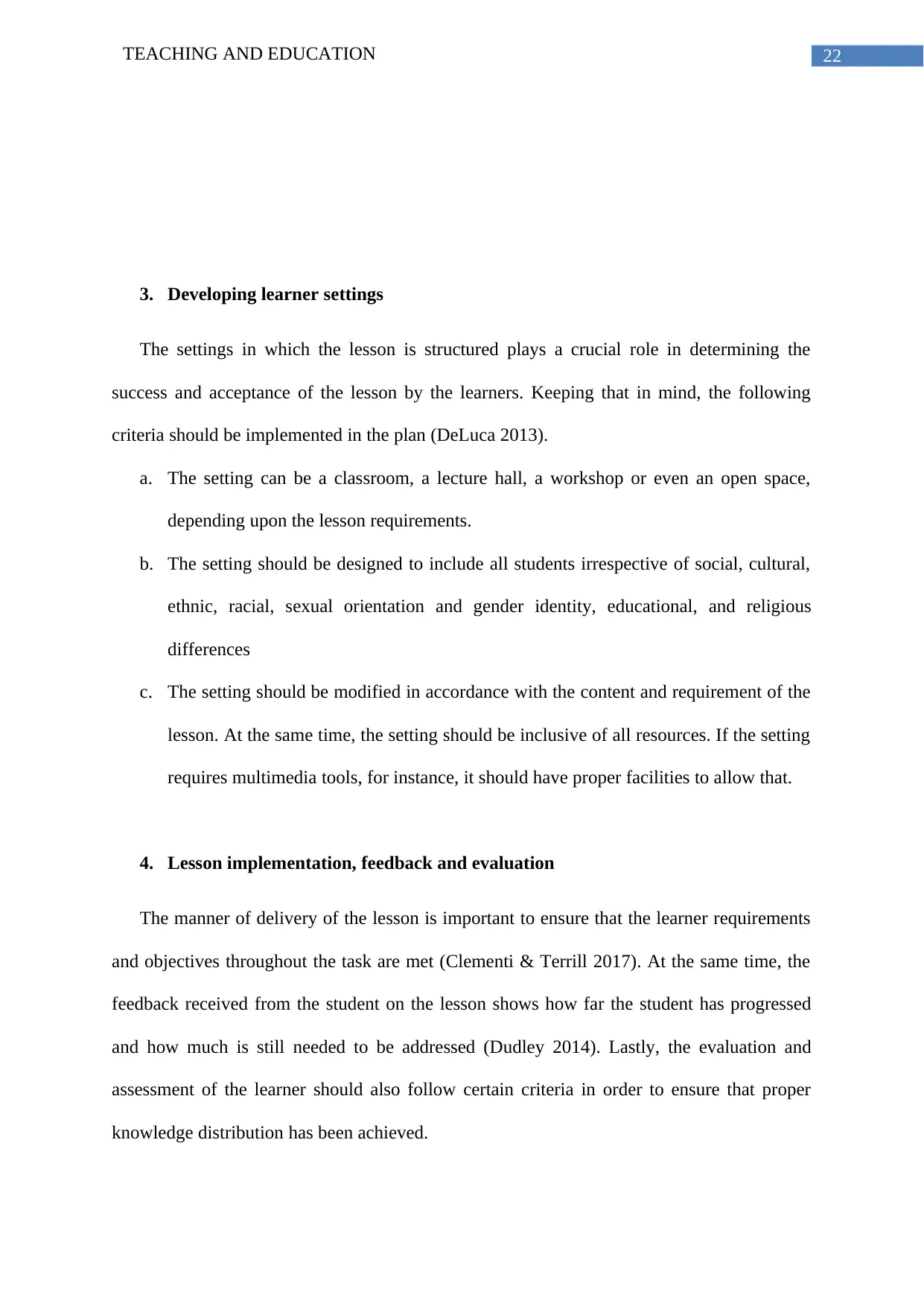
22TEACHING AND EDUCATION
3. Developing learner settings
The settings in which the lesson is structured plays a crucial role in determining the
success and acceptance of the lesson by the learners. Keeping that in mind, the following
criteria should be implemented in the plan (DeLuca 2013).
a. The setting can be a classroom, a lecture hall, a workshop or even an open space,
depending upon the lesson requirements.
b. The setting should be designed to include all students irrespective of social, cultural,
ethnic, racial, sexual orientation and gender identity, educational, and religious
differences
c. The setting should be modified in accordance with the content and requirement of the
lesson. At the same time, the setting should be inclusive of all resources. If the setting
requires multimedia tools, for instance, it should have proper facilities to allow that.
4. Lesson implementation, feedback and evaluation
The manner of delivery of the lesson is important to ensure that the learner requirements
and objectives throughout the task are met (Clementi & Terrill 2017). At the same time, the
feedback received from the student on the lesson shows how far the student has progressed
and how much is still needed to be addressed (Dudley 2014). Lastly, the evaluation and
assessment of the learner should also follow certain criteria in order to ensure that proper
knowledge distribution has been achieved.
3. Developing learner settings
The settings in which the lesson is structured plays a crucial role in determining the
success and acceptance of the lesson by the learners. Keeping that in mind, the following
criteria should be implemented in the plan (DeLuca 2013).
a. The setting can be a classroom, a lecture hall, a workshop or even an open space,
depending upon the lesson requirements.
b. The setting should be designed to include all students irrespective of social, cultural,
ethnic, racial, sexual orientation and gender identity, educational, and religious
differences
c. The setting should be modified in accordance with the content and requirement of the
lesson. At the same time, the setting should be inclusive of all resources. If the setting
requires multimedia tools, for instance, it should have proper facilities to allow that.
4. Lesson implementation, feedback and evaluation
The manner of delivery of the lesson is important to ensure that the learner requirements
and objectives throughout the task are met (Clementi & Terrill 2017). At the same time, the
feedback received from the student on the lesson shows how far the student has progressed
and how much is still needed to be addressed (Dudley 2014). Lastly, the evaluation and
assessment of the learner should also follow certain criteria in order to ensure that proper
knowledge distribution has been achieved.
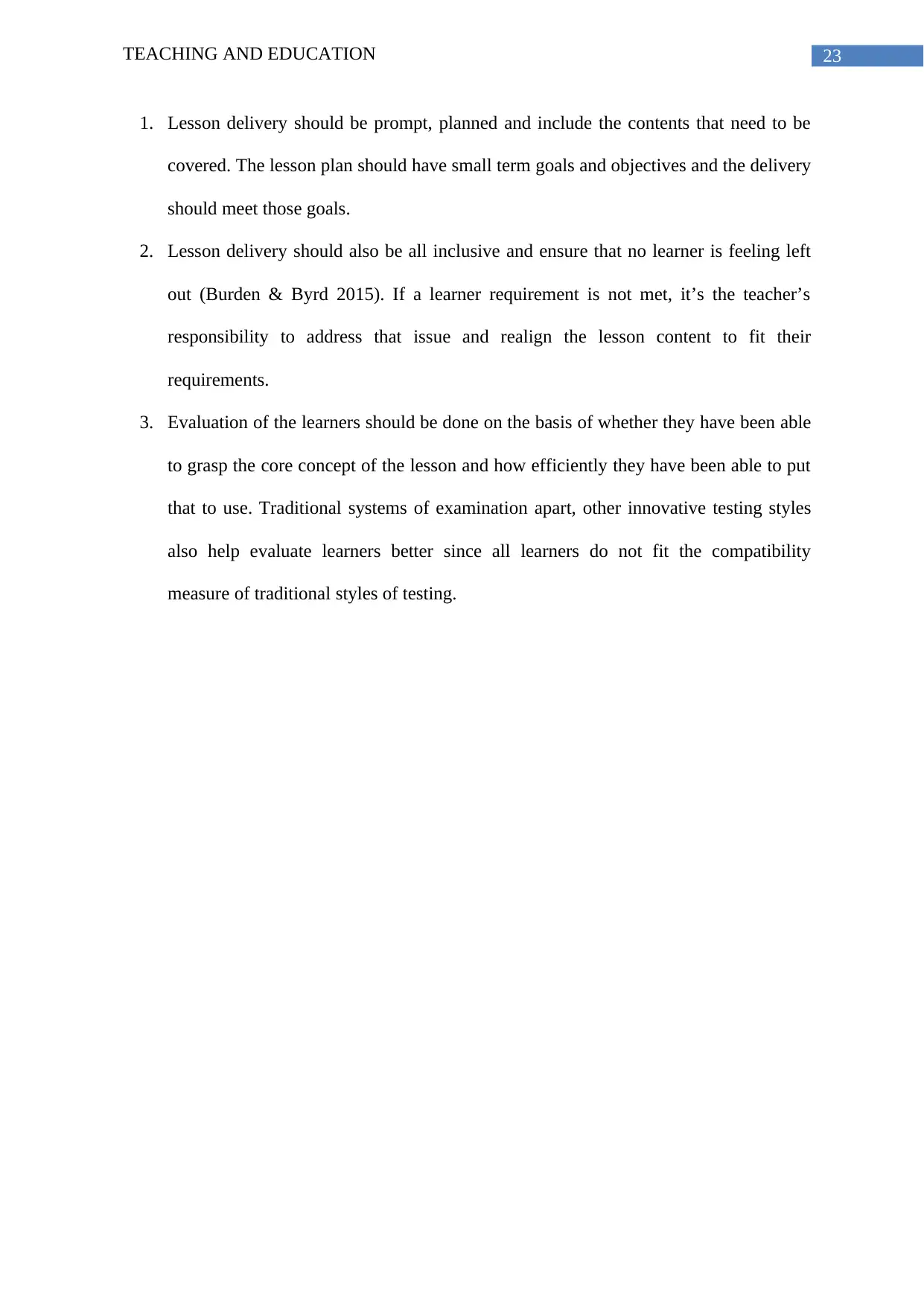
23TEACHING AND EDUCATION
1. Lesson delivery should be prompt, planned and include the contents that need to be
covered. The lesson plan should have small term goals and objectives and the delivery
should meet those goals.
2. Lesson delivery should also be all inclusive and ensure that no learner is feeling left
out (Burden & Byrd 2015). If a learner requirement is not met, it’s the teacher’s
responsibility to address that issue and realign the lesson content to fit their
requirements.
3. Evaluation of the learners should be done on the basis of whether they have been able
to grasp the core concept of the lesson and how efficiently they have been able to put
that to use. Traditional systems of examination apart, other innovative testing styles
also help evaluate learners better since all learners do not fit the compatibility
measure of traditional styles of testing.
1. Lesson delivery should be prompt, planned and include the contents that need to be
covered. The lesson plan should have small term goals and objectives and the delivery
should meet those goals.
2. Lesson delivery should also be all inclusive and ensure that no learner is feeling left
out (Burden & Byrd 2015). If a learner requirement is not met, it’s the teacher’s
responsibility to address that issue and realign the lesson content to fit their
requirements.
3. Evaluation of the learners should be done on the basis of whether they have been able
to grasp the core concept of the lesson and how efficiently they have been able to put
that to use. Traditional systems of examination apart, other innovative testing styles
also help evaluate learners better since all learners do not fit the compatibility
measure of traditional styles of testing.
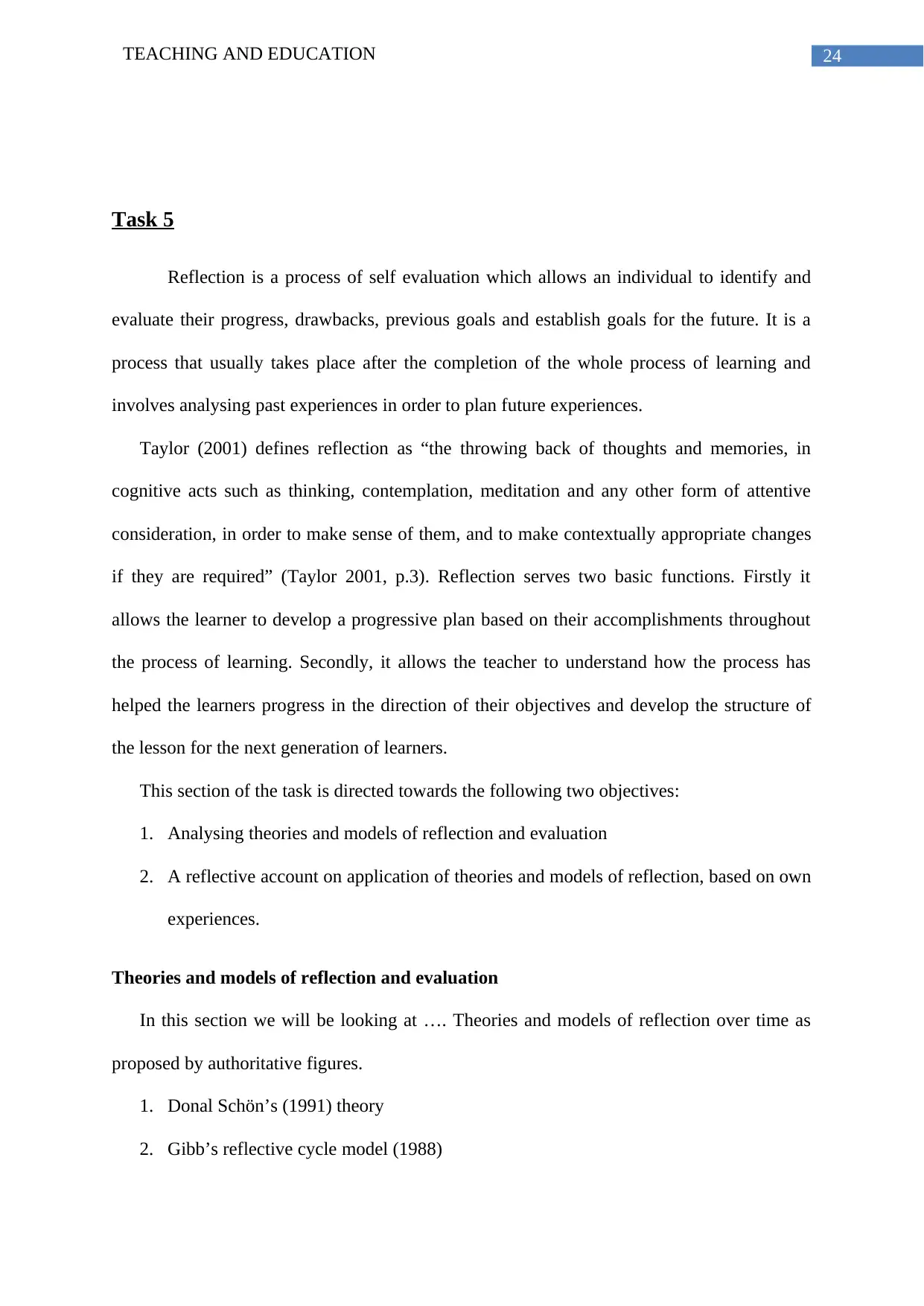
24TEACHING AND EDUCATION
Task 5
Reflection is a process of self evaluation which allows an individual to identify and
evaluate their progress, drawbacks, previous goals and establish goals for the future. It is a
process that usually takes place after the completion of the whole process of learning and
involves analysing past experiences in order to plan future experiences.
Taylor (2001) defines reflection as “the throwing back of thoughts and memories, in
cognitive acts such as thinking, contemplation, meditation and any other form of attentive
consideration, in order to make sense of them, and to make contextually appropriate changes
if they are required” (Taylor 2001, p.3). Reflection serves two basic functions. Firstly it
allows the learner to develop a progressive plan based on their accomplishments throughout
the process of learning. Secondly, it allows the teacher to understand how the process has
helped the learners progress in the direction of their objectives and develop the structure of
the lesson for the next generation of learners.
This section of the task is directed towards the following two objectives:
1. Analysing theories and models of reflection and evaluation
2. A reflective account on application of theories and models of reflection, based on own
experiences.
Theories and models of reflection and evaluation
In this section we will be looking at …. Theories and models of reflection over time as
proposed by authoritative figures.
1. Donal Schön’s (1991) theory
2. Gibb’s reflective cycle model (1988)
Task 5
Reflection is a process of self evaluation which allows an individual to identify and
evaluate their progress, drawbacks, previous goals and establish goals for the future. It is a
process that usually takes place after the completion of the whole process of learning and
involves analysing past experiences in order to plan future experiences.
Taylor (2001) defines reflection as “the throwing back of thoughts and memories, in
cognitive acts such as thinking, contemplation, meditation and any other form of attentive
consideration, in order to make sense of them, and to make contextually appropriate changes
if they are required” (Taylor 2001, p.3). Reflection serves two basic functions. Firstly it
allows the learner to develop a progressive plan based on their accomplishments throughout
the process of learning. Secondly, it allows the teacher to understand how the process has
helped the learners progress in the direction of their objectives and develop the structure of
the lesson for the next generation of learners.
This section of the task is directed towards the following two objectives:
1. Analysing theories and models of reflection and evaluation
2. A reflective account on application of theories and models of reflection, based on own
experiences.
Theories and models of reflection and evaluation
In this section we will be looking at …. Theories and models of reflection over time as
proposed by authoritative figures.
1. Donal Schön’s (1991) theory
2. Gibb’s reflective cycle model (1988)
Paraphrase This Document
Need a fresh take? Get an instant paraphrase of this document with our AI Paraphraser
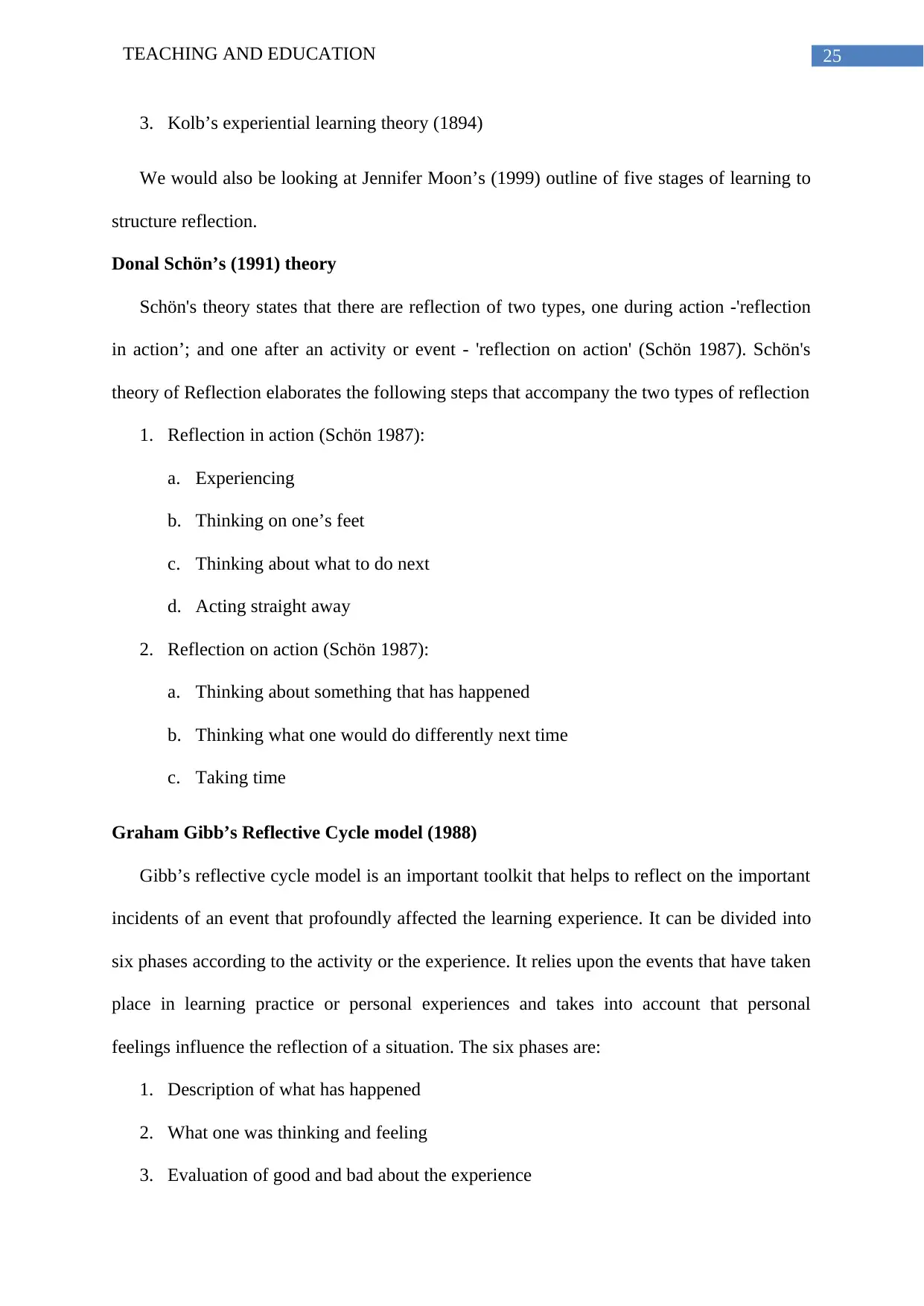
25TEACHING AND EDUCATION
3. Kolb’s experiential learning theory (1894)
We would also be looking at Jennifer Moon’s (1999) outline of five stages of learning to
structure reflection.
Donal Schön’s (1991) theory
Schön's theory states that there are reflection of two types, one during action -'reflection
in action’; and one after an activity or event - 'reflection on action' (Schön 1987). Schön's
theory of Reflection elaborates the following steps that accompany the two types of reflection
1. Reflection in action (Schön 1987):
a. Experiencing
b. Thinking on one’s feet
c. Thinking about what to do next
d. Acting straight away
2. Reflection on action (Schön 1987):
a. Thinking about something that has happened
b. Thinking what one would do differently next time
c. Taking time
Graham Gibb’s Reflective Cycle model (1988)
Gibb’s reflective cycle model is an important toolkit that helps to reflect on the important
incidents of an event that profoundly affected the learning experience. It can be divided into
six phases according to the activity or the experience. It relies upon the events that have taken
place in learning practice or personal experiences and takes into account that personal
feelings influence the reflection of a situation. The six phases are:
1. Description of what has happened
2. What one was thinking and feeling
3. Evaluation of good and bad about the experience
3. Kolb’s experiential learning theory (1894)
We would also be looking at Jennifer Moon’s (1999) outline of five stages of learning to
structure reflection.
Donal Schön’s (1991) theory
Schön's theory states that there are reflection of two types, one during action -'reflection
in action’; and one after an activity or event - 'reflection on action' (Schön 1987). Schön's
theory of Reflection elaborates the following steps that accompany the two types of reflection
1. Reflection in action (Schön 1987):
a. Experiencing
b. Thinking on one’s feet
c. Thinking about what to do next
d. Acting straight away
2. Reflection on action (Schön 1987):
a. Thinking about something that has happened
b. Thinking what one would do differently next time
c. Taking time
Graham Gibb’s Reflective Cycle model (1988)
Gibb’s reflective cycle model is an important toolkit that helps to reflect on the important
incidents of an event that profoundly affected the learning experience. It can be divided into
six phases according to the activity or the experience. It relies upon the events that have taken
place in learning practice or personal experiences and takes into account that personal
feelings influence the reflection of a situation. The six phases are:
1. Description of what has happened
2. What one was thinking and feeling
3. Evaluation of good and bad about the experience
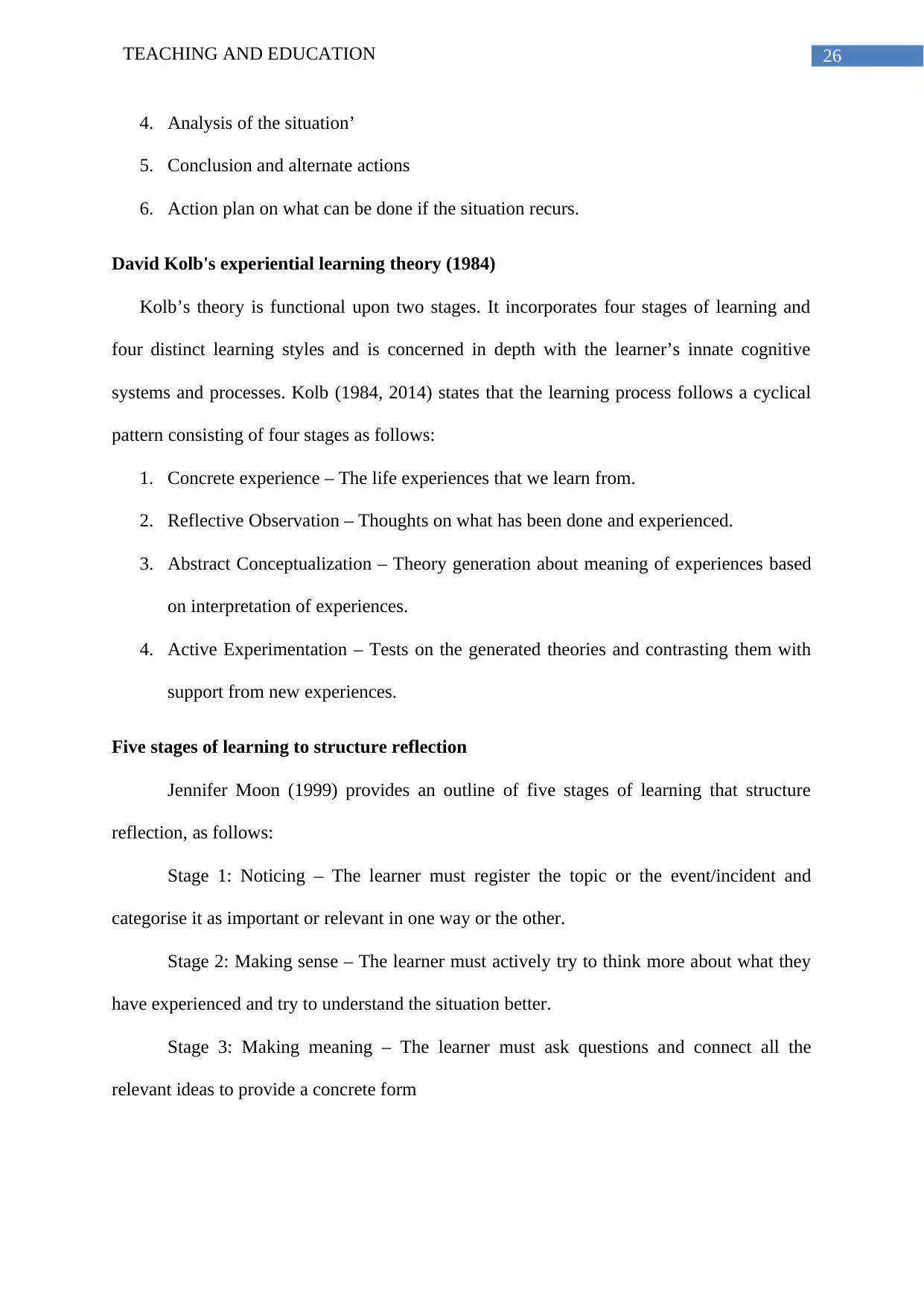
26TEACHING AND EDUCATION
4. Analysis of the situation’
5. Conclusion and alternate actions
6. Action plan on what can be done if the situation recurs.
David Kolb's experiential learning theory (1984)
Kolb’s theory is functional upon two stages. It incorporates four stages of learning and
four distinct learning styles and is concerned in depth with the learner’s innate cognitive
systems and processes. Kolb (1984, 2014) states that the learning process follows a cyclical
pattern consisting of four stages as follows:
1. Concrete experience – The life experiences that we learn from.
2. Reflective Observation – Thoughts on what has been done and experienced.
3. Abstract Conceptualization – Theory generation about meaning of experiences based
on interpretation of experiences.
4. Active Experimentation – Tests on the generated theories and contrasting them with
support from new experiences.
Five stages of learning to structure reflection
Jennifer Moon (1999) provides an outline of five stages of learning that structure
reflection, as follows:
Stage 1: Noticing – The learner must register the topic or the event/incident and
categorise it as important or relevant in one way or the other.
Stage 2: Making sense – The learner must actively try to think more about what they
have experienced and try to understand the situation better.
Stage 3: Making meaning – The learner must ask questions and connect all the
relevant ideas to provide a concrete form
4. Analysis of the situation’
5. Conclusion and alternate actions
6. Action plan on what can be done if the situation recurs.
David Kolb's experiential learning theory (1984)
Kolb’s theory is functional upon two stages. It incorporates four stages of learning and
four distinct learning styles and is concerned in depth with the learner’s innate cognitive
systems and processes. Kolb (1984, 2014) states that the learning process follows a cyclical
pattern consisting of four stages as follows:
1. Concrete experience – The life experiences that we learn from.
2. Reflective Observation – Thoughts on what has been done and experienced.
3. Abstract Conceptualization – Theory generation about meaning of experiences based
on interpretation of experiences.
4. Active Experimentation – Tests on the generated theories and contrasting them with
support from new experiences.
Five stages of learning to structure reflection
Jennifer Moon (1999) provides an outline of five stages of learning that structure
reflection, as follows:
Stage 1: Noticing – The learner must register the topic or the event/incident and
categorise it as important or relevant in one way or the other.
Stage 2: Making sense – The learner must actively try to think more about what they
have experienced and try to understand the situation better.
Stage 3: Making meaning – The learner must ask questions and connect all the
relevant ideas to provide a concrete form
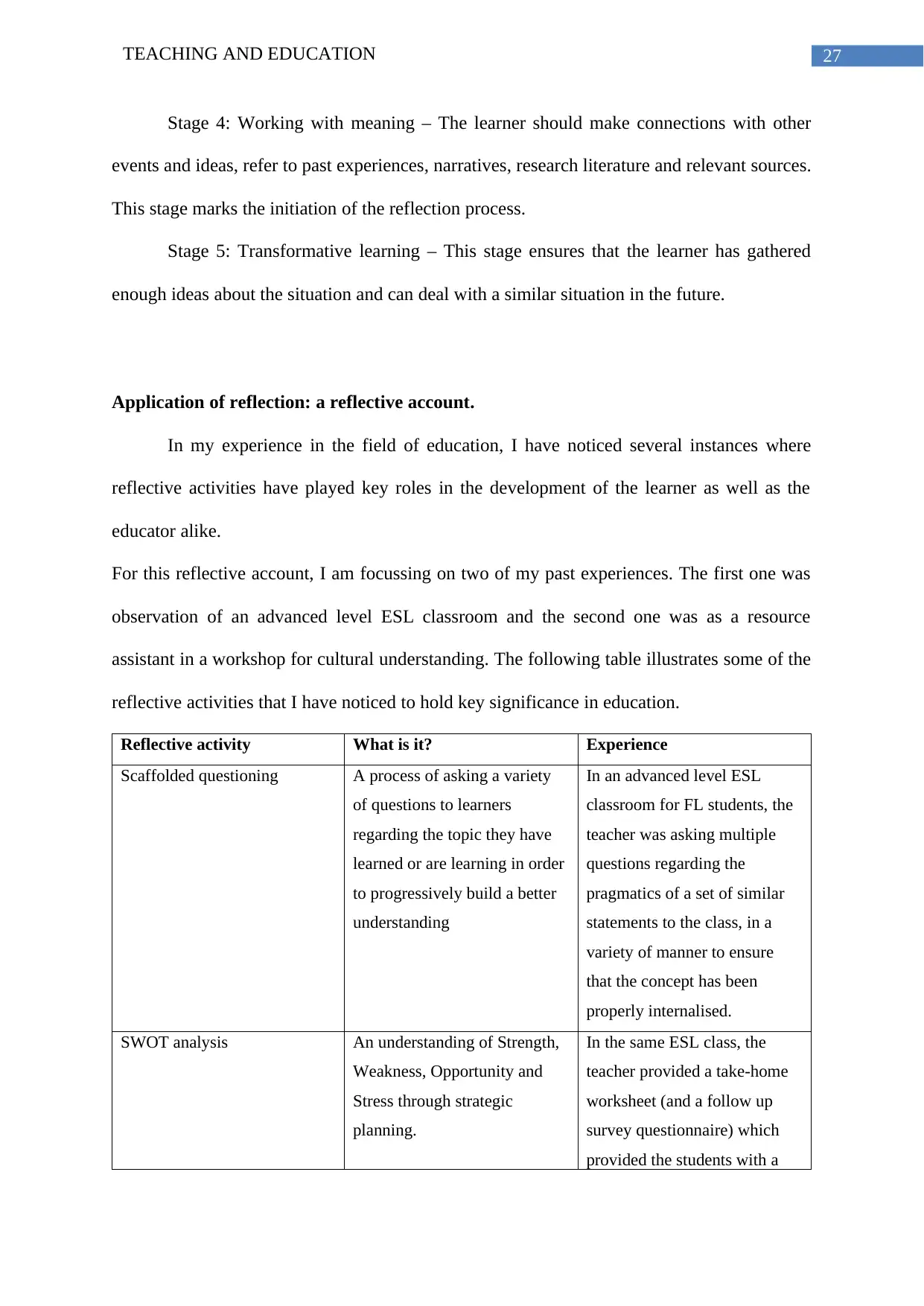
27TEACHING AND EDUCATION
Stage 4: Working with meaning – The learner should make connections with other
events and ideas, refer to past experiences, narratives, research literature and relevant sources.
This stage marks the initiation of the reflection process.
Stage 5: Transformative learning – This stage ensures that the learner has gathered
enough ideas about the situation and can deal with a similar situation in the future.
Application of reflection: a reflective account.
In my experience in the field of education, I have noticed several instances where
reflective activities have played key roles in the development of the learner as well as the
educator alike.
For this reflective account, I am focussing on two of my past experiences. The first one was
observation of an advanced level ESL classroom and the second one was as a resource
assistant in a workshop for cultural understanding. The following table illustrates some of the
reflective activities that I have noticed to hold key significance in education.
Reflective activity What is it? Experience
Scaffolded questioning A process of asking a variety
of questions to learners
regarding the topic they have
learned or are learning in order
to progressively build a better
understanding
In an advanced level ESL
classroom for FL students, the
teacher was asking multiple
questions regarding the
pragmatics of a set of similar
statements to the class, in a
variety of manner to ensure
that the concept has been
properly internalised.
SWOT analysis An understanding of Strength,
Weakness, Opportunity and
Stress through strategic
planning.
In the same ESL class, the
teacher provided a take-home
worksheet (and a follow up
survey questionnaire) which
provided the students with a
Stage 4: Working with meaning – The learner should make connections with other
events and ideas, refer to past experiences, narratives, research literature and relevant sources.
This stage marks the initiation of the reflection process.
Stage 5: Transformative learning – This stage ensures that the learner has gathered
enough ideas about the situation and can deal with a similar situation in the future.
Application of reflection: a reflective account.
In my experience in the field of education, I have noticed several instances where
reflective activities have played key roles in the development of the learner as well as the
educator alike.
For this reflective account, I am focussing on two of my past experiences. The first one was
observation of an advanced level ESL classroom and the second one was as a resource
assistant in a workshop for cultural understanding. The following table illustrates some of the
reflective activities that I have noticed to hold key significance in education.
Reflective activity What is it? Experience
Scaffolded questioning A process of asking a variety
of questions to learners
regarding the topic they have
learned or are learning in order
to progressively build a better
understanding
In an advanced level ESL
classroom for FL students, the
teacher was asking multiple
questions regarding the
pragmatics of a set of similar
statements to the class, in a
variety of manner to ensure
that the concept has been
properly internalised.
SWOT analysis An understanding of Strength,
Weakness, Opportunity and
Stress through strategic
planning.
In the same ESL class, the
teacher provided a take-home
worksheet (and a follow up
survey questionnaire) which
provided the students with a
Secure Best Marks with AI Grader
Need help grading? Try our AI Grader for instant feedback on your assignments.
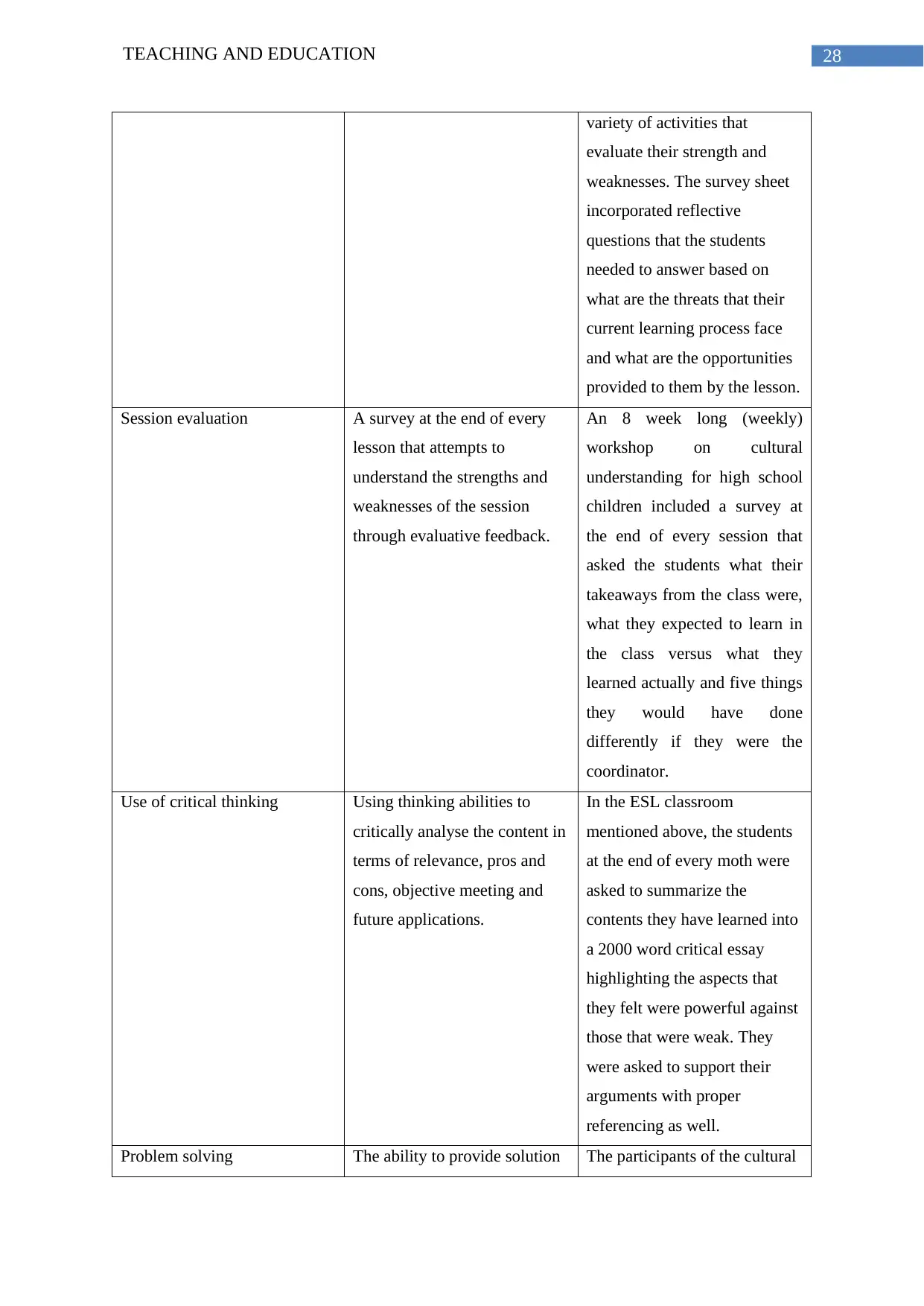
28TEACHING AND EDUCATION
variety of activities that
evaluate their strength and
weaknesses. The survey sheet
incorporated reflective
questions that the students
needed to answer based on
what are the threats that their
current learning process face
and what are the opportunities
provided to them by the lesson.
Session evaluation A survey at the end of every
lesson that attempts to
understand the strengths and
weaknesses of the session
through evaluative feedback.
An 8 week long (weekly)
workshop on cultural
understanding for high school
children included a survey at
the end of every session that
asked the students what their
takeaways from the class were,
what they expected to learn in
the class versus what they
learned actually and five things
they would have done
differently if they were the
coordinator.
Use of critical thinking Using thinking abilities to
critically analyse the content in
terms of relevance, pros and
cons, objective meeting and
future applications.
In the ESL classroom
mentioned above, the students
at the end of every moth were
asked to summarize the
contents they have learned into
a 2000 word critical essay
highlighting the aspects that
they felt were powerful against
those that were weak. They
were asked to support their
arguments with proper
referencing as well.
Problem solving The ability to provide solution The participants of the cultural
variety of activities that
evaluate their strength and
weaknesses. The survey sheet
incorporated reflective
questions that the students
needed to answer based on
what are the threats that their
current learning process face
and what are the opportunities
provided to them by the lesson.
Session evaluation A survey at the end of every
lesson that attempts to
understand the strengths and
weaknesses of the session
through evaluative feedback.
An 8 week long (weekly)
workshop on cultural
understanding for high school
children included a survey at
the end of every session that
asked the students what their
takeaways from the class were,
what they expected to learn in
the class versus what they
learned actually and five things
they would have done
differently if they were the
coordinator.
Use of critical thinking Using thinking abilities to
critically analyse the content in
terms of relevance, pros and
cons, objective meeting and
future applications.
In the ESL classroom
mentioned above, the students
at the end of every moth were
asked to summarize the
contents they have learned into
a 2000 word critical essay
highlighting the aspects that
they felt were powerful against
those that were weak. They
were asked to support their
arguments with proper
referencing as well.
Problem solving The ability to provide solution The participants of the cultural
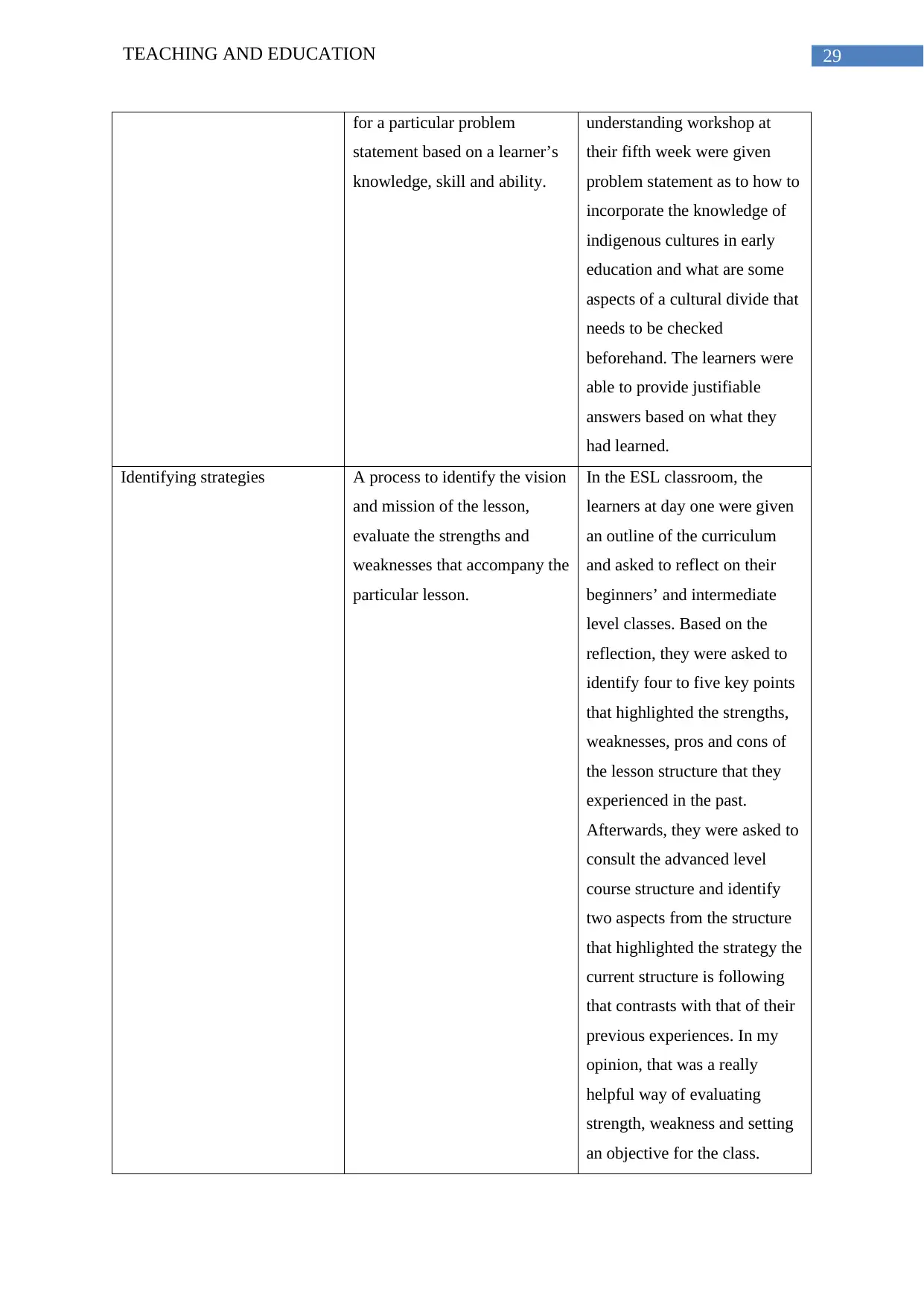
29TEACHING AND EDUCATION
for a particular problem
statement based on a learner’s
knowledge, skill and ability.
understanding workshop at
their fifth week were given
problem statement as to how to
incorporate the knowledge of
indigenous cultures in early
education and what are some
aspects of a cultural divide that
needs to be checked
beforehand. The learners were
able to provide justifiable
answers based on what they
had learned.
Identifying strategies A process to identify the vision
and mission of the lesson,
evaluate the strengths and
weaknesses that accompany the
particular lesson.
In the ESL classroom, the
learners at day one were given
an outline of the curriculum
and asked to reflect on their
beginners’ and intermediate
level classes. Based on the
reflection, they were asked to
identify four to five key points
that highlighted the strengths,
weaknesses, pros and cons of
the lesson structure that they
experienced in the past.
Afterwards, they were asked to
consult the advanced level
course structure and identify
two aspects from the structure
that highlighted the strategy the
current structure is following
that contrasts with that of their
previous experiences. In my
opinion, that was a really
helpful way of evaluating
strength, weakness and setting
an objective for the class.
for a particular problem
statement based on a learner’s
knowledge, skill and ability.
understanding workshop at
their fifth week were given
problem statement as to how to
incorporate the knowledge of
indigenous cultures in early
education and what are some
aspects of a cultural divide that
needs to be checked
beforehand. The learners were
able to provide justifiable
answers based on what they
had learned.
Identifying strategies A process to identify the vision
and mission of the lesson,
evaluate the strengths and
weaknesses that accompany the
particular lesson.
In the ESL classroom, the
learners at day one were given
an outline of the curriculum
and asked to reflect on their
beginners’ and intermediate
level classes. Based on the
reflection, they were asked to
identify four to five key points
that highlighted the strengths,
weaknesses, pros and cons of
the lesson structure that they
experienced in the past.
Afterwards, they were asked to
consult the advanced level
course structure and identify
two aspects from the structure
that highlighted the strategy the
current structure is following
that contrasts with that of their
previous experiences. In my
opinion, that was a really
helpful way of evaluating
strength, weakness and setting
an objective for the class.
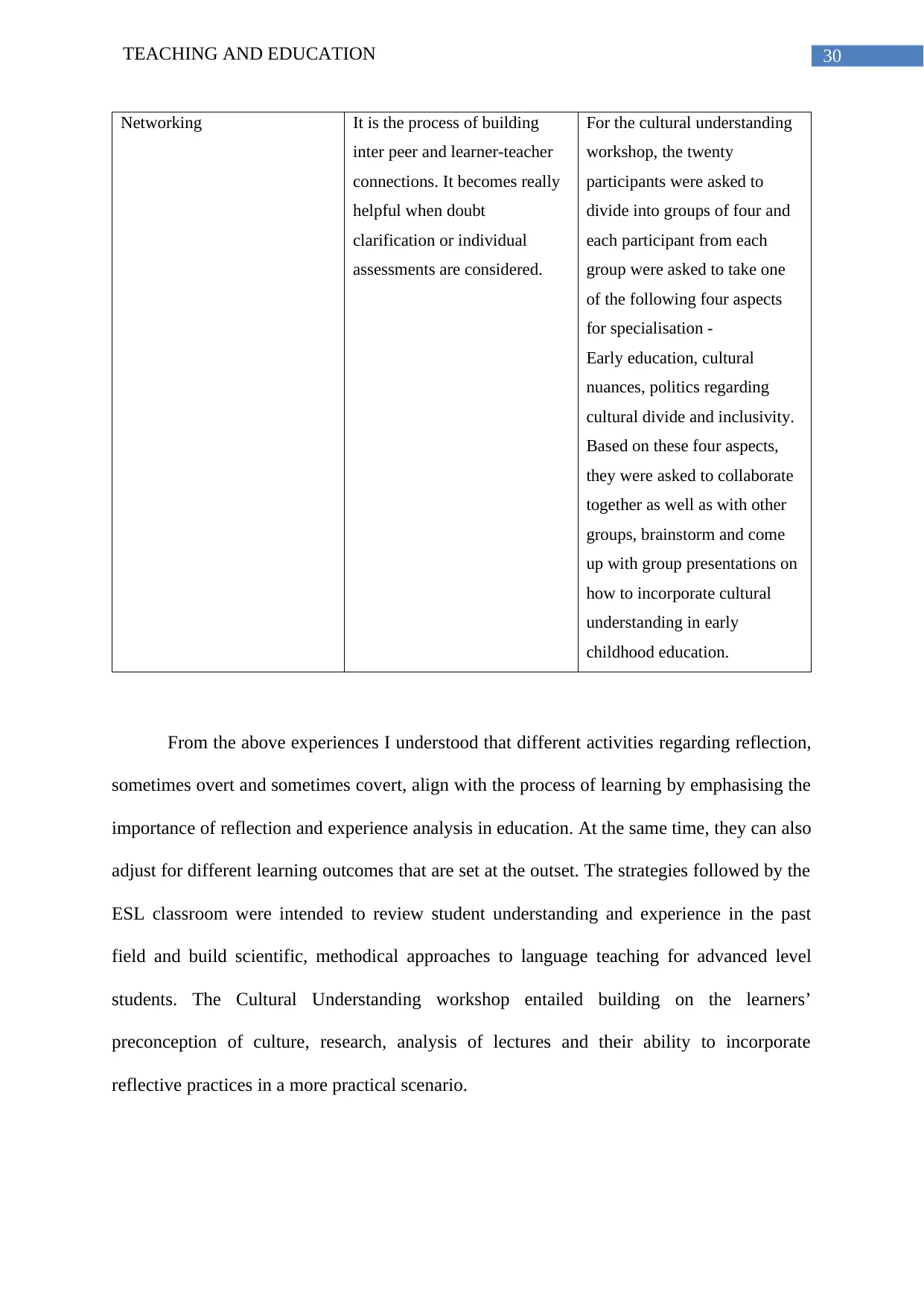
30TEACHING AND EDUCATION
Networking It is the process of building
inter peer and learner-teacher
connections. It becomes really
helpful when doubt
clarification or individual
assessments are considered.
For the cultural understanding
workshop, the twenty
participants were asked to
divide into groups of four and
each participant from each
group were asked to take one
of the following four aspects
for specialisation -
Early education, cultural
nuances, politics regarding
cultural divide and inclusivity.
Based on these four aspects,
they were asked to collaborate
together as well as with other
groups, brainstorm and come
up with group presentations on
how to incorporate cultural
understanding in early
childhood education.
From the above experiences I understood that different activities regarding reflection,
sometimes overt and sometimes covert, align with the process of learning by emphasising the
importance of reflection and experience analysis in education. At the same time, they can also
adjust for different learning outcomes that are set at the outset. The strategies followed by the
ESL classroom were intended to review student understanding and experience in the past
field and build scientific, methodical approaches to language teaching for advanced level
students. The Cultural Understanding workshop entailed building on the learners’
preconception of culture, research, analysis of lectures and their ability to incorporate
reflective practices in a more practical scenario.
Networking It is the process of building
inter peer and learner-teacher
connections. It becomes really
helpful when doubt
clarification or individual
assessments are considered.
For the cultural understanding
workshop, the twenty
participants were asked to
divide into groups of four and
each participant from each
group were asked to take one
of the following four aspects
for specialisation -
Early education, cultural
nuances, politics regarding
cultural divide and inclusivity.
Based on these four aspects,
they were asked to collaborate
together as well as with other
groups, brainstorm and come
up with group presentations on
how to incorporate cultural
understanding in early
childhood education.
From the above experiences I understood that different activities regarding reflection,
sometimes overt and sometimes covert, align with the process of learning by emphasising the
importance of reflection and experience analysis in education. At the same time, they can also
adjust for different learning outcomes that are set at the outset. The strategies followed by the
ESL classroom were intended to review student understanding and experience in the past
field and build scientific, methodical approaches to language teaching for advanced level
students. The Cultural Understanding workshop entailed building on the learners’
preconception of culture, research, analysis of lectures and their ability to incorporate
reflective practices in a more practical scenario.
Paraphrase This Document
Need a fresh take? Get an instant paraphrase of this document with our AI Paraphraser
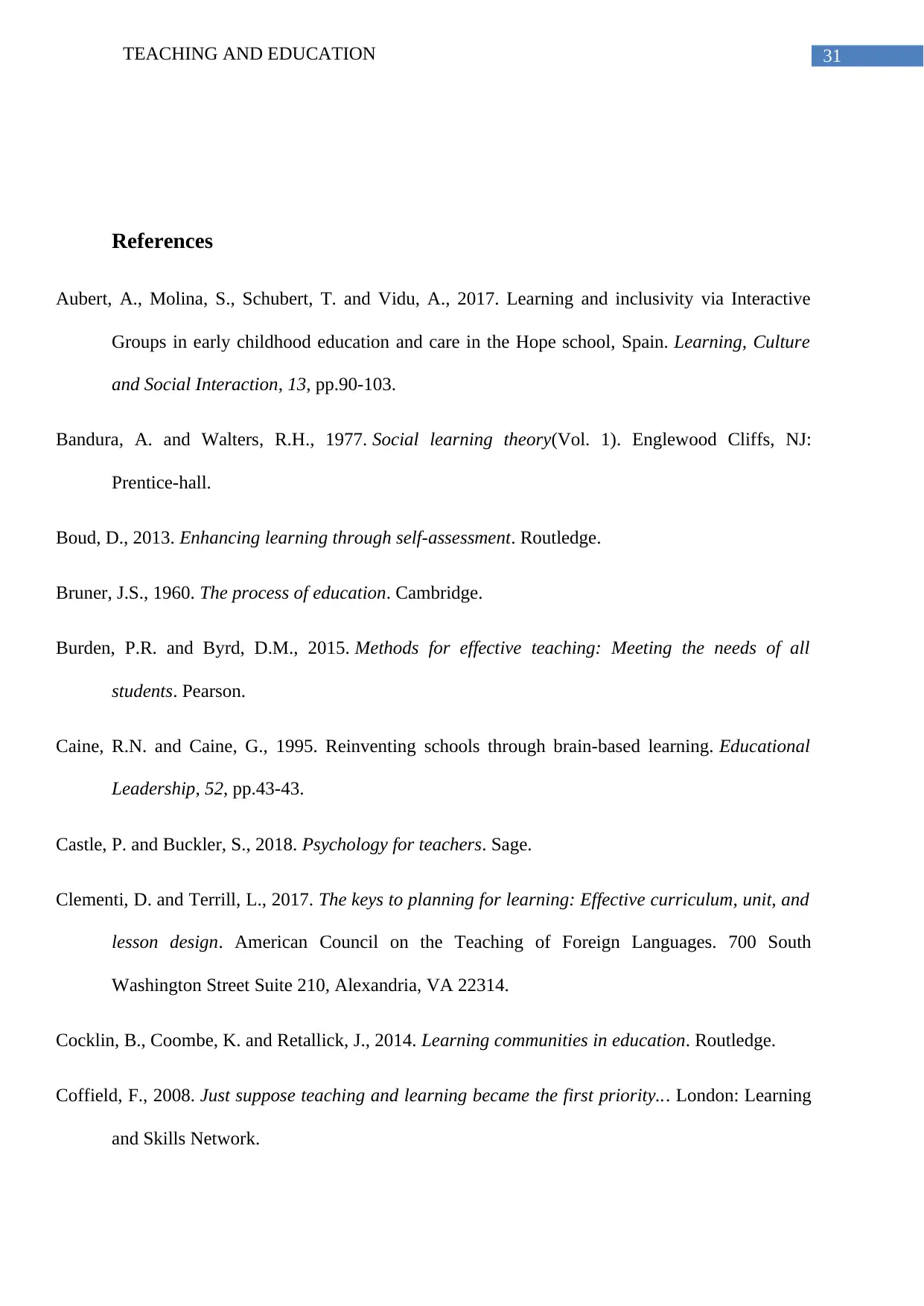
31TEACHING AND EDUCATION
References
Aubert, A., Molina, S., Schubert, T. and Vidu, A., 2017. Learning and inclusivity via Interactive
Groups in early childhood education and care in the Hope school, Spain. Learning, Culture
and Social Interaction, 13, pp.90-103.
Bandura, A. and Walters, R.H., 1977. Social learning theory(Vol. 1). Englewood Cliffs, NJ:
Prentice-hall.
Boud, D., 2013. Enhancing learning through self-assessment. Routledge.
Bruner, J.S., 1960. The process of education. Cambridge.
Burden, P.R. and Byrd, D.M., 2015. Methods for effective teaching: Meeting the needs of all
students. Pearson.
Caine, R.N. and Caine, G., 1995. Reinventing schools through brain-based learning. Educational
Leadership, 52, pp.43-43.
Castle, P. and Buckler, S., 2018. Psychology for teachers. Sage.
Clementi, D. and Terrill, L., 2017. The keys to planning for learning: Effective curriculum, unit, and
lesson design. American Council on the Teaching of Foreign Languages. 700 South
Washington Street Suite 210, Alexandria, VA 22314.
Cocklin, B., Coombe, K. and Retallick, J., 2014. Learning communities in education. Routledge.
Coffield, F., 2008. Just suppose teaching and learning became the first priority... London: Learning
and Skills Network.
References
Aubert, A., Molina, S., Schubert, T. and Vidu, A., 2017. Learning and inclusivity via Interactive
Groups in early childhood education and care in the Hope school, Spain. Learning, Culture
and Social Interaction, 13, pp.90-103.
Bandura, A. and Walters, R.H., 1977. Social learning theory(Vol. 1). Englewood Cliffs, NJ:
Prentice-hall.
Boud, D., 2013. Enhancing learning through self-assessment. Routledge.
Bruner, J.S., 1960. The process of education. Cambridge.
Burden, P.R. and Byrd, D.M., 2015. Methods for effective teaching: Meeting the needs of all
students. Pearson.
Caine, R.N. and Caine, G., 1995. Reinventing schools through brain-based learning. Educational
Leadership, 52, pp.43-43.
Castle, P. and Buckler, S., 2018. Psychology for teachers. Sage.
Clementi, D. and Terrill, L., 2017. The keys to planning for learning: Effective curriculum, unit, and
lesson design. American Council on the Teaching of Foreign Languages. 700 South
Washington Street Suite 210, Alexandria, VA 22314.
Cocklin, B., Coombe, K. and Retallick, J., 2014. Learning communities in education. Routledge.
Coffield, F., 2008. Just suppose teaching and learning became the first priority... London: Learning
and Skills Network.
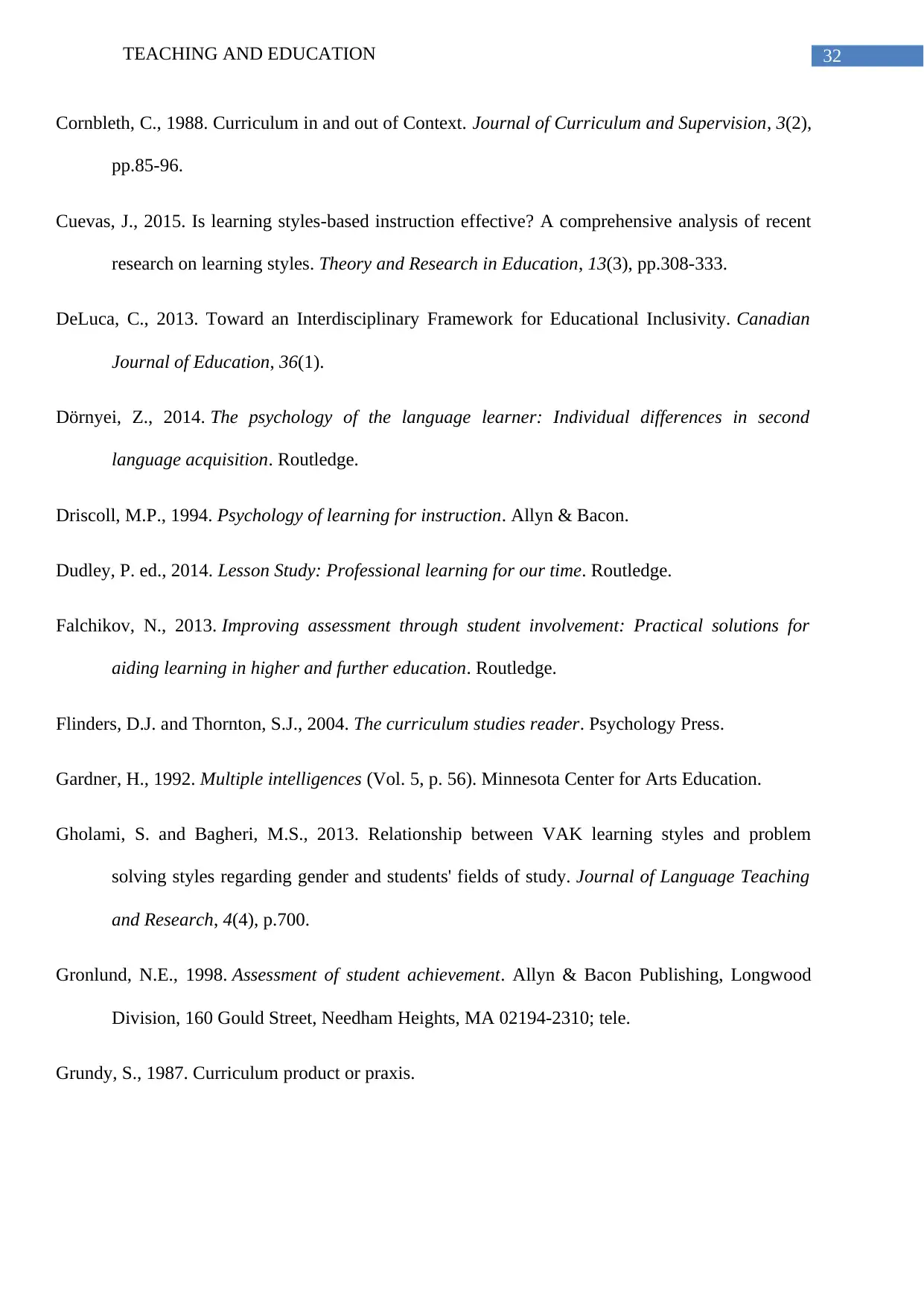
32TEACHING AND EDUCATION
Cornbleth, C., 1988. Curriculum in and out of Context. Journal of Curriculum and Supervision, 3(2),
pp.85-96.
Cuevas, J., 2015. Is learning styles-based instruction effective? A comprehensive analysis of recent
research on learning styles. Theory and Research in Education, 13(3), pp.308-333.
DeLuca, C., 2013. Toward an Interdisciplinary Framework for Educational Inclusivity. Canadian
Journal of Education, 36(1).
Dörnyei, Z., 2014. The psychology of the language learner: Individual differences in second
language acquisition. Routledge.
Driscoll, M.P., 1994. Psychology of learning for instruction. Allyn & Bacon.
Dudley, P. ed., 2014. Lesson Study: Professional learning for our time. Routledge.
Falchikov, N., 2013. Improving assessment through student involvement: Practical solutions for
aiding learning in higher and further education. Routledge.
Flinders, D.J. and Thornton, S.J., 2004. The curriculum studies reader. Psychology Press.
Gardner, H., 1992. Multiple intelligences (Vol. 5, p. 56). Minnesota Center for Arts Education.
Gholami, S. and Bagheri, M.S., 2013. Relationship between VAK learning styles and problem
solving styles regarding gender and students' fields of study. Journal of Language Teaching
and Research, 4(4), p.700.
Gronlund, N.E., 1998. Assessment of student achievement. Allyn & Bacon Publishing, Longwood
Division, 160 Gould Street, Needham Heights, MA 02194-2310; tele.
Grundy, S., 1987. Curriculum product or praxis.
Cornbleth, C., 1988. Curriculum in and out of Context. Journal of Curriculum and Supervision, 3(2),
pp.85-96.
Cuevas, J., 2015. Is learning styles-based instruction effective? A comprehensive analysis of recent
research on learning styles. Theory and Research in Education, 13(3), pp.308-333.
DeLuca, C., 2013. Toward an Interdisciplinary Framework for Educational Inclusivity. Canadian
Journal of Education, 36(1).
Dörnyei, Z., 2014. The psychology of the language learner: Individual differences in second
language acquisition. Routledge.
Driscoll, M.P., 1994. Psychology of learning for instruction. Allyn & Bacon.
Dudley, P. ed., 2014. Lesson Study: Professional learning for our time. Routledge.
Falchikov, N., 2013. Improving assessment through student involvement: Practical solutions for
aiding learning in higher and further education. Routledge.
Flinders, D.J. and Thornton, S.J., 2004. The curriculum studies reader. Psychology Press.
Gardner, H., 1992. Multiple intelligences (Vol. 5, p. 56). Minnesota Center for Arts Education.
Gholami, S. and Bagheri, M.S., 2013. Relationship between VAK learning styles and problem
solving styles regarding gender and students' fields of study. Journal of Language Teaching
and Research, 4(4), p.700.
Gronlund, N.E., 1998. Assessment of student achievement. Allyn & Bacon Publishing, Longwood
Division, 160 Gould Street, Needham Heights, MA 02194-2310; tele.
Grundy, S., 1987. Curriculum product or praxis.
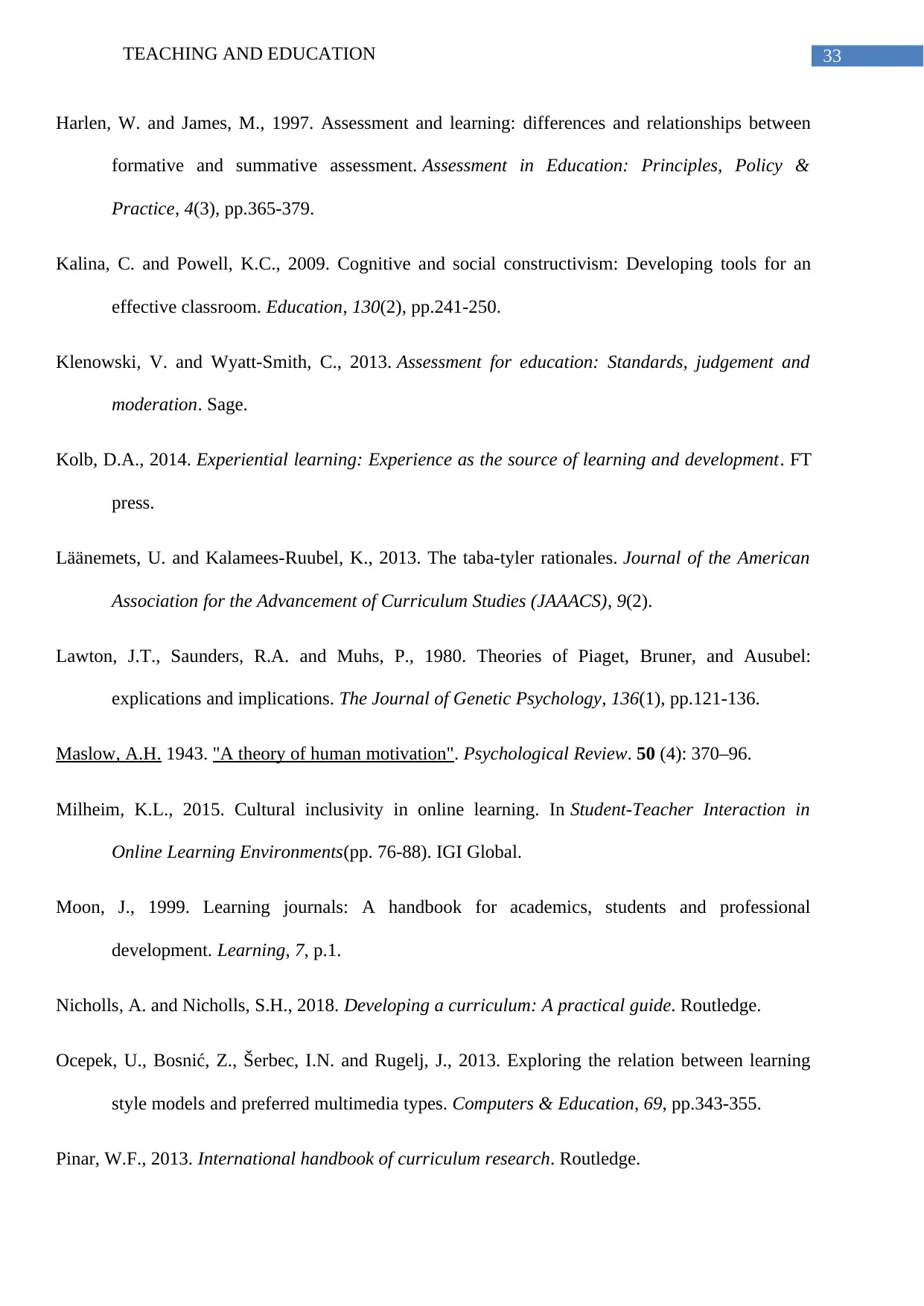
33TEACHING AND EDUCATION
Harlen, W. and James, M., 1997. Assessment and learning: differences and relationships between
formative and summative assessment. Assessment in Education: Principles, Policy &
Practice, 4(3), pp.365-379.
Kalina, C. and Powell, K.C., 2009. Cognitive and social constructivism: Developing tools for an
effective classroom. Education, 130(2), pp.241-250.
Klenowski, V. and Wyatt-Smith, C., 2013. Assessment for education: Standards, judgement and
moderation. Sage.
Kolb, D.A., 2014. Experiential learning: Experience as the source of learning and development. FT
press.
Läänemets, U. and Kalamees-Ruubel, K., 2013. The taba-tyler rationales. Journal of the American
Association for the Advancement of Curriculum Studies (JAAACS), 9(2).
Lawton, J.T., Saunders, R.A. and Muhs, P., 1980. Theories of Piaget, Bruner, and Ausubel:
explications and implications. The Journal of Genetic Psychology, 136(1), pp.121-136.
Maslow, A.H. 1943. "A theory of human motivation". Psychological Review. 50 (4): 370–96.
Milheim, K.L., 2015. Cultural inclusivity in online learning. In Student-Teacher Interaction in
Online Learning Environments(pp. 76-88). IGI Global.
Moon, J., 1999. Learning journals: A handbook for academics, students and professional
development. Learning, 7, p.1.
Nicholls, A. and Nicholls, S.H., 2018. Developing a curriculum: A practical guide. Routledge.
Ocepek, U., Bosnić, Z., Šerbec, I.N. and Rugelj, J., 2013. Exploring the relation between learning
style models and preferred multimedia types. Computers & Education, 69, pp.343-355.
Pinar, W.F., 2013. International handbook of curriculum research. Routledge.
Harlen, W. and James, M., 1997. Assessment and learning: differences and relationships between
formative and summative assessment. Assessment in Education: Principles, Policy &
Practice, 4(3), pp.365-379.
Kalina, C. and Powell, K.C., 2009. Cognitive and social constructivism: Developing tools for an
effective classroom. Education, 130(2), pp.241-250.
Klenowski, V. and Wyatt-Smith, C., 2013. Assessment for education: Standards, judgement and
moderation. Sage.
Kolb, D.A., 2014. Experiential learning: Experience as the source of learning and development. FT
press.
Läänemets, U. and Kalamees-Ruubel, K., 2013. The taba-tyler rationales. Journal of the American
Association for the Advancement of Curriculum Studies (JAAACS), 9(2).
Lawton, J.T., Saunders, R.A. and Muhs, P., 1980. Theories of Piaget, Bruner, and Ausubel:
explications and implications. The Journal of Genetic Psychology, 136(1), pp.121-136.
Maslow, A.H. 1943. "A theory of human motivation". Psychological Review. 50 (4): 370–96.
Milheim, K.L., 2015. Cultural inclusivity in online learning. In Student-Teacher Interaction in
Online Learning Environments(pp. 76-88). IGI Global.
Moon, J., 1999. Learning journals: A handbook for academics, students and professional
development. Learning, 7, p.1.
Nicholls, A. and Nicholls, S.H., 2018. Developing a curriculum: A practical guide. Routledge.
Ocepek, U., Bosnić, Z., Šerbec, I.N. and Rugelj, J., 2013. Exploring the relation between learning
style models and preferred multimedia types. Computers & Education, 69, pp.343-355.
Pinar, W.F., 2013. International handbook of curriculum research. Routledge.
Secure Best Marks with AI Grader
Need help grading? Try our AI Grader for instant feedback on your assignments.
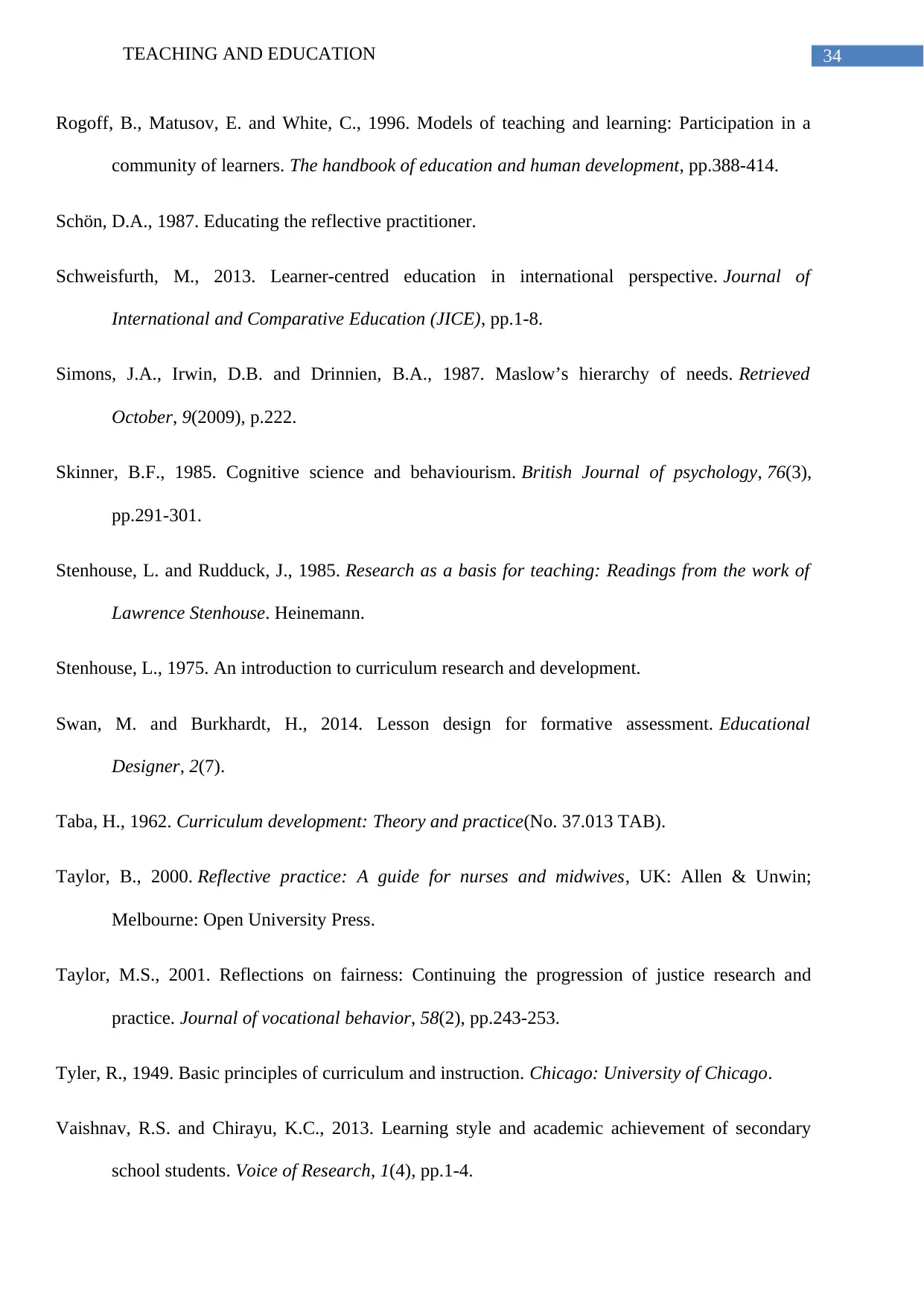
34TEACHING AND EDUCATION
Rogoff, B., Matusov, E. and White, C., 1996. Models of teaching and learning: Participation in a
community of learners. The handbook of education and human development, pp.388-414.
Schön, D.A., 1987. Educating the reflective practitioner.
Schweisfurth, M., 2013. Learner-centred education in international perspective. Journal of
International and Comparative Education (JICE), pp.1-8.
Simons, J.A., Irwin, D.B. and Drinnien, B.A., 1987. Maslow’s hierarchy of needs. Retrieved
October, 9(2009), p.222.
Skinner, B.F., 1985. Cognitive science and behaviourism. British Journal of psychology, 76(3),
pp.291-301.
Stenhouse, L. and Rudduck, J., 1985. Research as a basis for teaching: Readings from the work of
Lawrence Stenhouse. Heinemann.
Stenhouse, L., 1975. An introduction to curriculum research and development.
Swan, M. and Burkhardt, H., 2014. Lesson design for formative assessment. Educational
Designer, 2(7).
Taba, H., 1962. Curriculum development: Theory and practice(No. 37.013 TAB).
Taylor, B., 2000. Reflective practice: A guide for nurses and midwives, UK: Allen & Unwin;
Melbourne: Open University Press.
Taylor, M.S., 2001. Reflections on fairness: Continuing the progression of justice research and
practice. Journal of vocational behavior, 58(2), pp.243-253.
Tyler, R., 1949. Basic principles of curriculum and instruction. Chicago: University of Chicago.
Vaishnav, R.S. and Chirayu, K.C., 2013. Learning style and academic achievement of secondary
school students. Voice of Research, 1(4), pp.1-4.
Rogoff, B., Matusov, E. and White, C., 1996. Models of teaching and learning: Participation in a
community of learners. The handbook of education and human development, pp.388-414.
Schön, D.A., 1987. Educating the reflective practitioner.
Schweisfurth, M., 2013. Learner-centred education in international perspective. Journal of
International and Comparative Education (JICE), pp.1-8.
Simons, J.A., Irwin, D.B. and Drinnien, B.A., 1987. Maslow’s hierarchy of needs. Retrieved
October, 9(2009), p.222.
Skinner, B.F., 1985. Cognitive science and behaviourism. British Journal of psychology, 76(3),
pp.291-301.
Stenhouse, L. and Rudduck, J., 1985. Research as a basis for teaching: Readings from the work of
Lawrence Stenhouse. Heinemann.
Stenhouse, L., 1975. An introduction to curriculum research and development.
Swan, M. and Burkhardt, H., 2014. Lesson design for formative assessment. Educational
Designer, 2(7).
Taba, H., 1962. Curriculum development: Theory and practice(No. 37.013 TAB).
Taylor, B., 2000. Reflective practice: A guide for nurses and midwives, UK: Allen & Unwin;
Melbourne: Open University Press.
Taylor, M.S., 2001. Reflections on fairness: Continuing the progression of justice research and
practice. Journal of vocational behavior, 58(2), pp.243-253.
Tyler, R., 1949. Basic principles of curriculum and instruction. Chicago: University of Chicago.
Vaishnav, R.S. and Chirayu, K.C., 2013. Learning style and academic achievement of secondary
school students. Voice of Research, 1(4), pp.1-4.
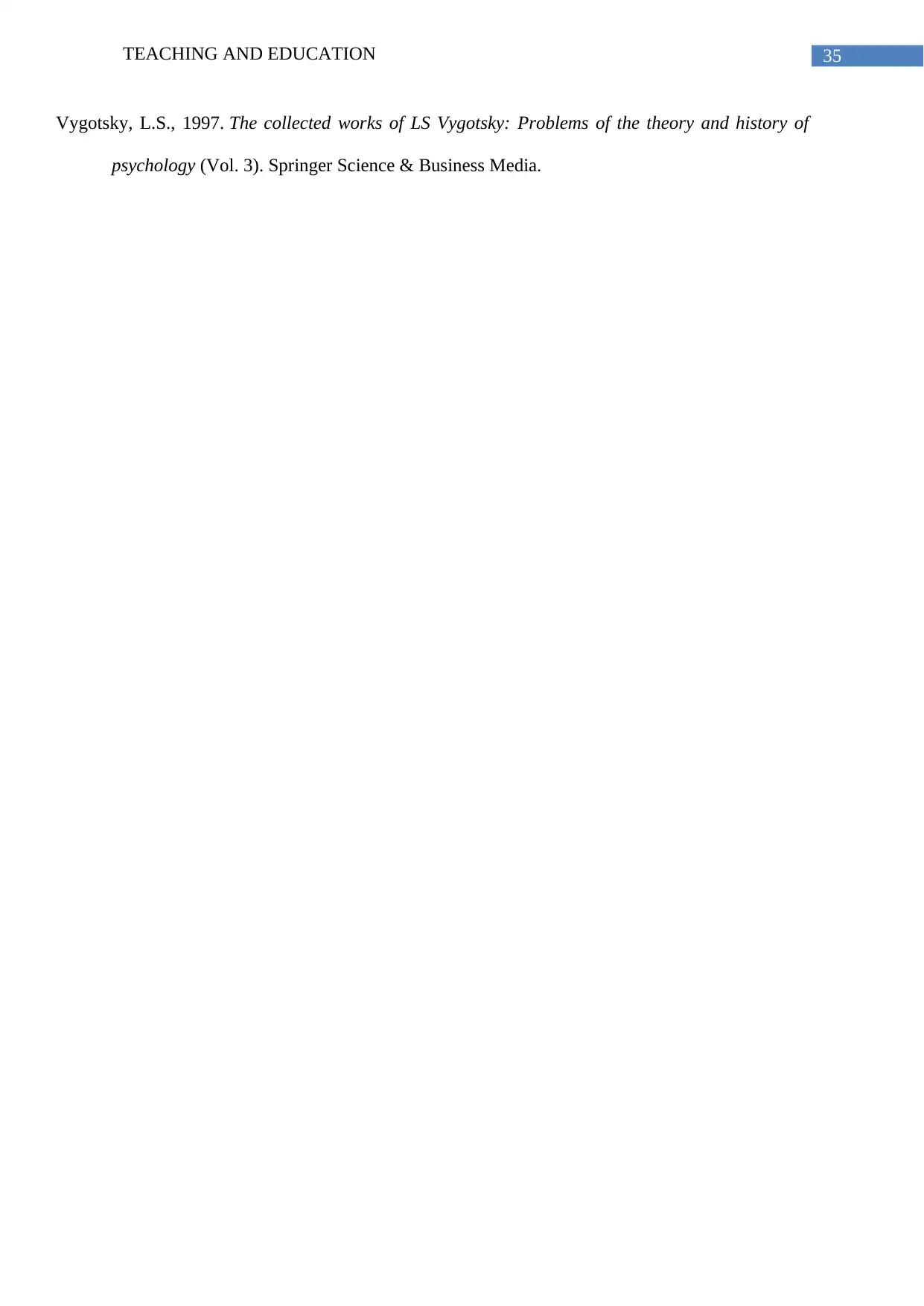
35TEACHING AND EDUCATION
Vygotsky, L.S., 1997. The collected works of LS Vygotsky: Problems of the theory and history of
psychology (Vol. 3). Springer Science & Business Media.
Vygotsky, L.S., 1997. The collected works of LS Vygotsky: Problems of the theory and history of
psychology (Vol. 3). Springer Science & Business Media.
1 out of 36
Related Documents
Your All-in-One AI-Powered Toolkit for Academic Success.
+13062052269
info@desklib.com
Available 24*7 on WhatsApp / Email
![[object Object]](/_next/static/media/star-bottom.7253800d.svg)
Unlock your academic potential
© 2024 | Zucol Services PVT LTD | All rights reserved.



